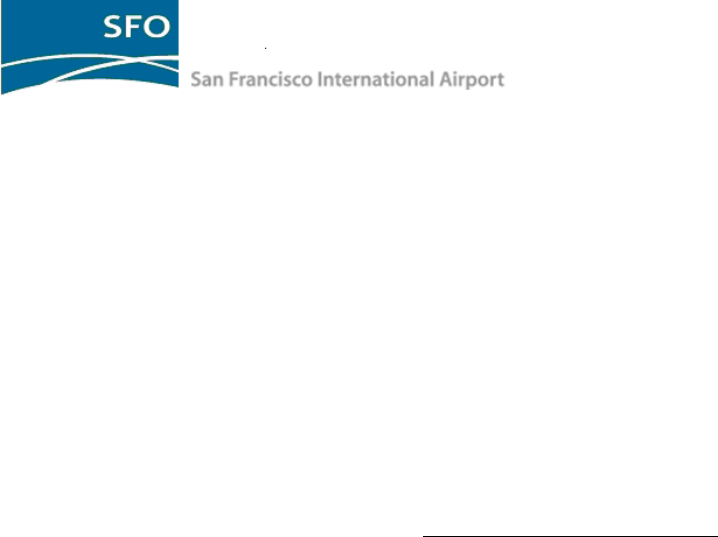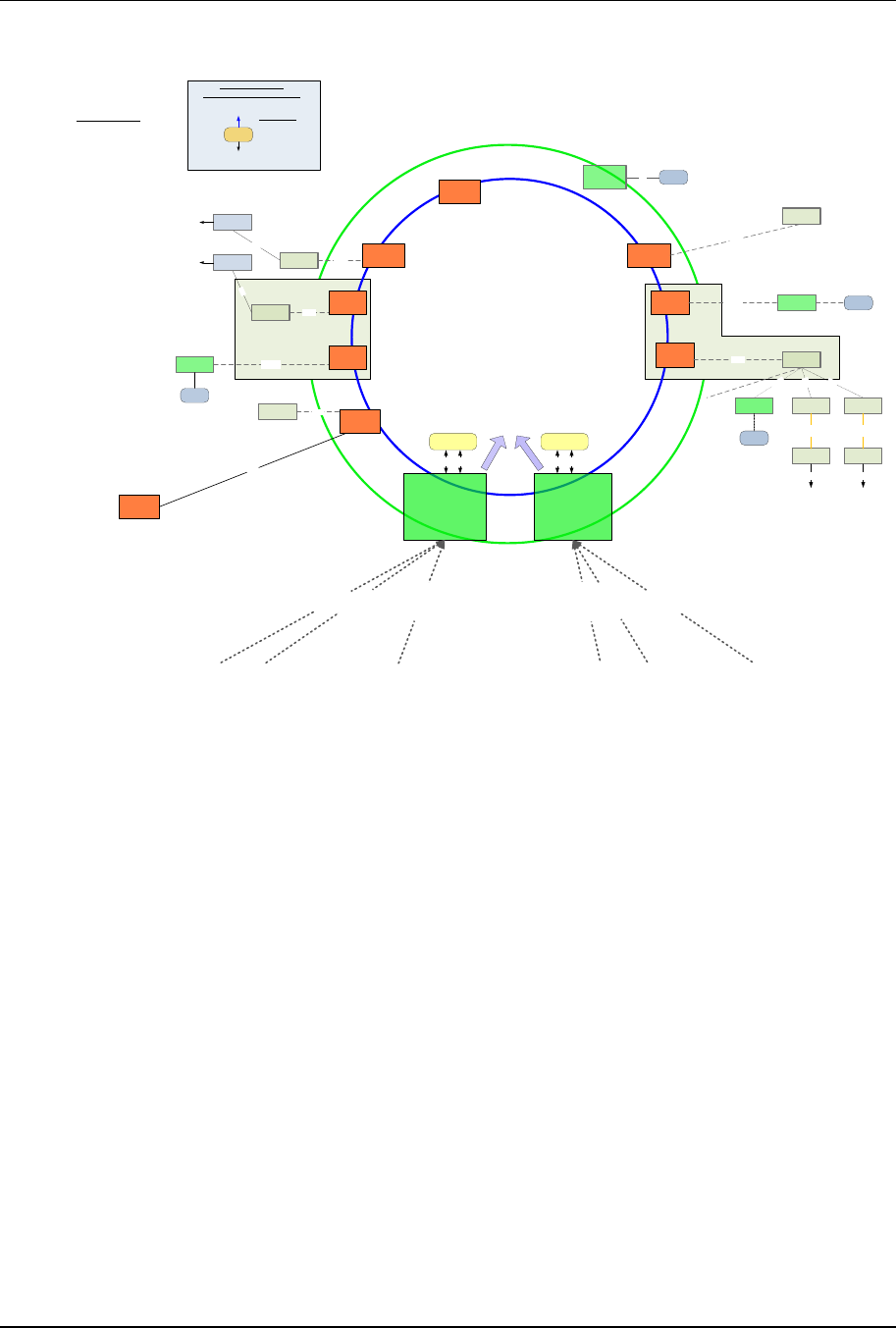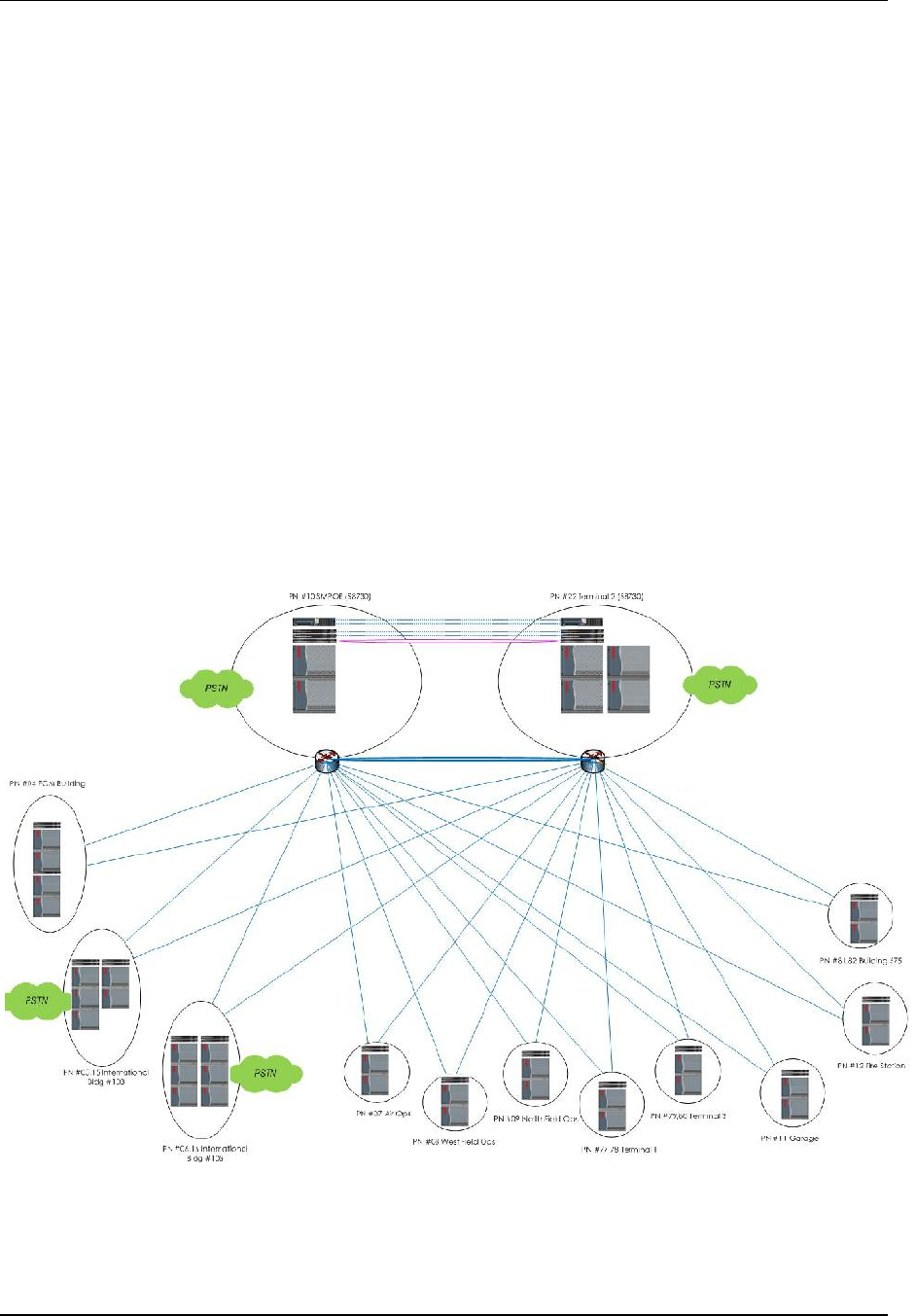Bay Networks Terminal Server 3395A FA19554
User Manual: Bay Networks Terminal Server 3395A
Open the PDF directly: View PDF ![]() .
.
Page Count: 68

SFO ITT Operating Environment:
Current and Targeted (OECT)
Version: 3.6
Formerly the Platform Compatibility Matrix
Prepared by:
SFO Information Technology and Telecommunications
Last updated on:
October 7, 2009

October 2009 SFO Page ii
DOCUMENT INFORMATION ..................................................................................1
AUTHORS .....................................................................................................................1
APPROVERS .................................................................................................................1
EDIT HISTORY .............................................................................................................1
DISTRIBUTION LIST .....................................................................................................2
INTRODUCTION .........................................................................................................3
BACKGROUND .............................................................................................................3
INFORMATION TECHNOLOGY AND TELECOMMUNICATIONS (ITT) ...............................3
DESKTOP PLATFORMS ...........................................................................................5
STANDARD DESKTOP HARDWARE ...............................................................................5
STANDARD LAPTOP HARDWARE ..................................................................................5
STANDARD SOFTWARE ................................................................................................6
OPTIONAL SOFTWARE .................................................................................................6
SERVER HARDWARE PLATFORM .......................................................................6
STANDARD SERVER HARDWARE .................................................................................7
STORAGE AREA NETWORK ..........................................................................................7
NON-STANDARD SERVER HARDWARE .........................................................................7
SERVER VIRTUALIZATION ...........................................................................................8
OPERATING SYSTEMS .............................................................................................8
WINDOWS SERVER ......................................................................................................8
LINUX ..........................................................................................................................8
OTHER OPERATING SYSTEMS ......................................................................................8
NETWORKS .................................................................................................................9
GENERAL .....................................................................................................................9
ETHERNET-BASED NETWORK EQUIPMENT ...................................................................9
SONET NETWORK DESCRIPTION AND HARDWARE ...................................................12
STANDARDS AND PROTOCOLS ...................................................................................15
APPLICATION PLATFORMS AND COMPONENTS .........................................17
APPLICATION DEVELOPMENT PLATFORMS ................................................................17
APPLICATION HOSTING PLATFORMS ..........................................................................17
ENTERPRISE APPLICATION INTEGRATION MODEL .....................................................18
DATA WAREHOUSING REQUIREMENTS ......................................................................19
TELECOM ..................................................................................................................21
SYSTEMS SUPPORT AND MAINTENANCE .......................................................22
ITT SERVICE DESK ....................................................................................................22
ITT NETWORK OPERATIONS CENTER ........................................................................22
HOURS OF OPERATION ...............................................................................................22
MAINTENANCE WINDOWS .........................................................................................23
SHARED SUPPORT RESPONSIBILITIES .........................................................................23
CHANGE MANAGEMENT PROCESS .............................................................................23
SECURITY AND IT BEST PRACTICES ................................................................24
SITE SECURITY ..........................................................................................................24
INFORMATION SECURITY ...........................................................................................24

October 2009 SFO Page iii
BEST PRACTICES ........................................................................................................25
QUALITY ASSURANCE ...............................................................................................25
SYSTEM MONITORING REQUIREMENTS ........................................................26
INTRODUCTION ..........................................................................................................26
THE SIMPLE NETWORK MANAGEMENT PROTOCOL (SNMP) .....................................26
SNMP QUESTIONS FOR VENDORS .............................................................................26
SELECTED SNMP AND PUBLIC MIB REFERENCES ....................................................27
GENERAL LOG FILE OBJECTIVES ...............................................................................27
SYSLOGS ....................................................................................................................28
SYSLOG QUESTIONS FOR VENDORS ...........................................................................28
APPENDIX A – STANDARDS FOR OSI LAYERS 1-4 .........................................30
APPENDIX B – STANDARDS, REGULATIONS AND BEST PRACTICES .....55
APPENDIX C – SNMP MIB SUPPORT QUESTIONNAIRE ...............................61

SFO ITT Operating Environment: Current And Targeted (OECT) Document Information
October 2009 SFO Page 1
Document Information
Authors
Table 1 lists the authors and their contact information.
Table 1 – Document Authors
Names
Title
Email
Phone
Bo Pitsker
Lead, Solutions
Architecture
bo.pitsker@flysfo.com
650.821.4316
Erik
Joelsson
Manager/Systems
Engineering
erik.joelsson@flysfo.com
650.821.4362
Martin
Taras
Manager/Application
Development
martin.taras@flysfo.com
650.821.3380
Rene
Leedeman
Manager/Telecom
rene.leedeman@flysfo.com
650.821.3395
Zihong
Gorman
Director/Information
Access
zihong.gorman@flysfo.com
650.821.3368
Approvers
The following approvals are required for this document to take effect.
Table 2 – Document Approval
Approver Names
Title/Department
Daniel Gonzales
Director, Technical Services
Rene Leedeman
Director, Communications Services
Frank Lara
Director, Quality Assurance and ITIL
Ray Ricardo
Director, Projects and Planning Services
Zihong Gorman
Director, Information Engineering Services
Jonathan Kaplan
CISO/Director, Information Security Services
John Payne
CIO
Edit History
Table 3 – Document Edit History
Version
Date
Who
Revision
1.4
2006
Oren Eshel
Created the original ―ITT Standards‖
2.1
2/18/2008
Zee Gorman
Re-created and renamed the
document
2.2
6/30/2008
Zee Gorman
Added SNMP Requirement Section
authored by Bo Pitsker

SFO ITT Operating Environment: Current And Targeted (OECT) Document Information
October 2009 SFO Page 2
Version
Date
Who
Revision
2.3
7/7/2008
Zee Gorman
Updated SNMP Requirements
Section and renamed it to Systems
Monitoring Requirements.
3.0
7/9/2008
Bo Pitsker
Completed ―Networks‖ section;
provided new frameworks for other
sections
3.1
8/11/2008
Erik Joelsson
Updated Systems Section
3.1
8/11/2008
Rene Leedeman
Updated Telecom Section
3.2
8/12/2008
Zee Gorman
Updated Applications Section
3.3
8/16/2008
Zee Gorman
Edits for section and table
consistency
3.4
9/2/2008
Zee Gorman
Updated ―Application‖ sections and
moved some of the contents to
appendix
3.5
12/4/2008
Bo Pitsker
Updated System Monitoring,
Appendices A and B
3.6
9/6/2009
Bo Pitsker
Changed title; added new intro;
added new desktop section; updated
Networks section; added to
Appendices A and B extensively
Distribution List
This document should be distributed to program managers and project managers of all
SFO projects with an ITT systems implementation components, who can distribute to
all parties including vendors and consultants engaged in building these components.

SFO ITT Operating Environment: Current And Targeted (OECT) Introduction
October 2009 SFO Page 3
Introduction
SFO Information Technology and Telecommunications (ITT)’s operating environment
is complex and diverse. It supports both internal Airport staff and numerous revenue
generating customers, including airlines, concessionaires, tenants and support services,
as well as contractors, visitors, and passengers.
Suppliers, vendors, consultants and others supplying good or services must acquaint
themselves with ITT’s current and targeted operating environments, so that they can
furnish offerings that integrate easily into the Airport’s IT infrastructure. It is
incumbent upon outside offerors to explain and rationalize why their products and/or
services are not consistent with the Airport’s current or future operating environments.
This document provides a high-level view into all aspects of the operating
environment, and furnished extensive references to internal and external standards and
guidelines. However, it is intended to be descriptive and not necessarily normative.
Background
San Francisco International Airport (―SFO‖) is the principal commercial services
airport for the San Francisco Bay Area. The San Francisco Airport Commission
operates the Airport as a separate enterprise department of the City and County of San
Francisco (the ―City‖). The Airport Commission manages a talented and committed
alliance of Airport staff, airlines, concessionaires, consultants, contractors, and support
organizations who operate and maintain the Airport facilities that accommodate air
and ground transportation for more than 33 million passengers and over half a million
metric tons of cargo each year. The total number of airlines flying out of SFO exceeds
55, with United and American being the largest carriers.
SFO is comprised of 3 domestic terminals and an international terminal. The domestic
terminals are a total square footage of 2.6 million, 66 gates, and 25 baggage carousals.
The International terminal has 1.8 million square feet, 24 gates, and 25 baggage
carousals. SFO’s annual revenues are approximately $503M, and the airport is 14th in
size domestically, and 30th in size worldwide. Airport commission staff number about
1,300. Total employment at SFO from all sources approaches 30,000.
Information Technology and Telecommunications (ITT)
The Information Technology and Telecommunications organization has as its mission
―to provide access to information to enable better business decisions.‖ It is an element
of the Administration section of the Airport, and is headed by John M. Payne, Chief
Information Officer (CIO). ITT offers a wide range of services to the Airport
Commission, airlines and tenants, and passengers. It has 65 employees, and an annual
budget of approximately $12 million, excluding capital projects. ITT is divided into a
number of service groups:

SFO ITT Operating Environment: Current And Targeted (OECT) Introduction
October 2009 SFO Page 4
Table 4 – SFO ITT Service Groups
Group
Services provided
Business Services
IT-related procurements; vendor management; finance; budgets; HR
Information Engineering
Services
Application development and support; database and application
consulting; data warehousing; business reporting and analytics
Technical Services
Application hosting and support; data storage; desktop and software
services; computers and peripherals; service desk and support; remote
access; email
Project and Planning
Services
Project management; customer relationship management; change
management
Communication Services
Voice services; network services, including Ethernet, SONET, Internet
access and WAN circuits; cabling and physical connectivity
Information Security
Services
Security management; risk management; compliance
Quality Assurance
Product testing and evaluation; ITIL implementation
Technical Design Services
Enterprise architecture; collaborative platform development, IT standards
ITT produces significant revenue for the Airport via its ASIC and STS services,
include voice, data and video services.

SFO ITT Operating Environment: Current And Targeted (OECT) Desktop Platforms
October 2009 SFO Page 5
Desktop Platforms
SFO targets specified minimum configurations as outlined in the following tables. The
installed base of Commission users may or may not possess the current platforms, as
the desktop refresh cycle at SFO is 4 – 5 years.
Standard Desktop Hardware
The current supplier of choice is Dell Computer.
Table 5 – Standard Desktop Hardware
Component
Description
Processor
E8000 series Intel® Core™2 Duo/Quad 6M/4M, 1333 FSB (2.0 GHz or
higher)
Memory (RAM)
2 GB 800 MHz DDR2 SDRAM (Expandable to 4GB)
Mass Storage
80 GB SATA II (7200 rpm), upgradable to additional 80, 120 or 200 GB
Video
256 MB integrated Intel® Graphics Media Accelerator 4500 or better
Network Adapter
10/100/1000 Gbit/s integrated on motherboard
Removable media
CDRW/DVD combo drive
Monitor
19" Dell Ultra Sharp flat panel
Keyboard
Standard USB
Mouse
USB 2-button entry mouse with scroll
Model(s)
Dell Optiplex 745/755/760
Form factor
Desktop (15.7‖ x 4.5‖ x 13.9‖ approx.)
Standard Laptop Hardware
The current supplier of choice is Dell Computer. IBM/Lenovo Thinkpads were
previously deployed widely, and many remain in the field.
Table 5 – Standard Laptop Hardware
Component
Description
Processor
E8000 series Intel® Core™2 Duo, 1333 FSB (2.0 GHz or higher)
Memory (RAM)
2 GB 800 MHz DDR2 SDRAM (Expandable to 8GB)
Mass Storage
80 GB SATA II (7200 rpm), upgradable to additional 80, 120 or 160 GB
Video
256 MB integrated Intel® Graphics Media Accelerator 4500 or
NVIDIA® Quadro® NVS 160M or better
Network Adapter, wired
10/100/1000 Gbit/s integrated on motherboard
Network Adapter, 802.11
Intel WiFi Link 5300 [802.11a/g/n (3x3)]
Removable media
CDRW/DVD combo drive
Monitor
14.1" UltraSharpTM WXGA+ (1440x900) LED Display
Keyboard
Standard (built-in)
Mouse
USB 2-button entry mouse with scroll
Model(s)
Dell Latitude E6400 (4.3 lbs)
Dell Latitude E4200 (2.2 lbs)
Form factor
Laptop (13.1‖ x 9.37‖ x 1.5‖ approx.)

SFO ITT Operating Environment: Current And Targeted (OECT) Server Hardware Platform
October 2009 SFO Page 6
Standard Software
The following software is included in the base image, with patches applied as
available.
Table 7 – Standard Client Software
Type
Description
Operating System
Windows XP, SP 3 [will transition to Windows 7 in near future]
Application Suite
Microsoft Office 2007, SP3
Internet Browser
IE 6/7
Email Client
Microsoft Outlook 2007 (with Exchange 2007 server)
PDF Viewer
Adobe Reader 8.1.6
Flash
Adobe Flash Player 10.0.32.18
Anti-Virus
Symantec Endpoint Protection Ver:11.0.4202.75/12 (coming soon)
Remote Access (VPN)
Cisco VPN Client 4.8.02/5.0.05.0290
Java JRE
Sun Java SE JRE 6, 6u16
.NET Framework
Microsoft .NET Framework 3.5 SP1
Optional Software
The following software is available as needed, but is not in the base image, with
patches applied as available.
Table 8 – Optional Client Software
Type
Description
Client Database
Microsoft Access 2007, SP1
Project Management
Microsoft Project 2007, SP2
PDF Document Creation
Adobe Acrobat Standard, 8.1.5
Image Processing
Adobe Photoshop CS4 11.0.1
Graphics
Adobe Photoshop CS4 11.0.1
Microsoft Visio 2007, SP2
Mainframe Terminal
Emulation
Rumba 2000
Employee Time
Accounting
Tess
Database Reporting
EIS/Cognos
Server Hardware Platform
SFO utilizes IBM BladeCenter technology with Intel based blades as a standard
hardware platform across all servers to allow efficient use of resources and to facilitate
business resumption.

SFO ITT Operating Environment: Current And Targeted (OECT) Server Hardware Platform
October 2009 SFO Page 7
Standard Server Hardware
The IBM BladeCenter solution1 is used for all Intel-based servers. SFO supports the
use of the HS22 or newer model line. SFO ITT does not support AMD, POWER,
PowerXCell or Cell/B.E. based IBM blades.
Where BladeCenter technology is not sufficient SFO will utilize IBM System x series
servers. Please note that the use of non-blade servers at SFO is dependent on many
factors, including but not limited to: available rack space, HVAC, Fiber-Channel and
network port availability.
All server systems must be compatible with the IBM Systems Director Server
platform management suite of centralized management tools, version 6.1.1 or newer
current version. The use of this tool ensures a uniform hardware deployment and
configuration so that SFO-ITT can honor business resumption requirements and
various service level agreements (SLA). All OS deployment and redeployment is
handled by the Remote Deployment Manage (RDM) extension to IBM Systems
Director Server.
All system backups at SFO are done centrally with IBM Tivoli Storage Manager
(TSM) backup suite. IBM servers supplied by third parties must be configured for
management by ITT’s IBM Director and the support contract transferred to SFO
before they can be considered a production system.
Storage Area Network
Where local storage is not sufficient or does not meet retention or other policies, SFO
are reliant upon SAN storage. The SAN storage is based on the EMC Clariion product
line and Brocade Fiber Channel Switches, providing Fiber Channel storage and remote
mirroring capabilities between separate locations on the Airport campus. Failover
controllers are implemented at each storage facility. Multiple paths between facilities
are available to the operating system for failover, and logical drives are partitioned so
that they are visible only to the intended operating system.
Any application where SAN storage is requested must work with this setup.
SFO uses Navisphere on all SAN management servers for SAN management, any new
SAN systems must support Navisphere management application v 6.26 or newer.
Non-standard Server Hardware
Non Intel based IBM-Blade Servers, non System x hardware is considered on an
individual basis.
1 Additional information about the IBM Blade Center platform is available at:
http://www-03.ibm.com/systems/bladecenter/hardware/servers/x86.html

SFO ITT Operating Environment: Current And Targeted (OECT) Operating Systems
October 2009 SFO Page 8
Server Virtualization
ITT has standardized its virtualization strategy around EMC’s VMWare product line,
including ESX VMs, VirtualCenter, and VMotion.
Operating Systems
SFO will support servers running both Microsoft Windows 2003, Standard and
Enterprise Server, or newer. SFO will also support SuSE Linux Enterprise Server 10.
Windows Server
SFO will support the Windows Server family of operating system, version 2003 SP2
and later, both 32bit and 64bit.
Before connected to the production network all servers must be configured with
Symantec Antivirus software, centrally managed by SFO-ITT, SFO AV management
server is Symantec’s SEP 11 or newer current version.
All Windows installation must support and be configured for SFO’s implementation
of Microsoft System Center Configuration Manager 2007SP1, or newer current
version.
OS support includes Network Load Balancing (NLB) and Windows Cluster setups,
Standard applications that come bundled with Windows are usually supported, some
of which include Active Directory, IIS web and IIS ftp, and DNS server.
Linux
SFO supports two Linux server distributions: Red Hat Enterprise Linux (RHEL) 5.4 or
later, and Novell SuSE Enterprise Server (SLES) 11.0 or later. Applications included
with the distributions are generally supported, as is the default package managers for
the distributions. Community editions and/or derivative distributions may be
considered on a case by case basis, but will be discouraged. Note that SFO does not
support Linux desktop distributions at this time.
Other Operating Systems
Any other operating system is considered on an individual basis.

SFO ITT Operating Environment: Current And Targeted (OECT) Networks
October 2009 SFO Page 9
Networks
General
The SFO network is a three-tier network with complex connectivity requirements. The
network consists of approximately 300+ network devices, ranging from Cisco Catalyst
6509s to ASA 5500 firewalls. The Airport also operates an OC-48 SONET ring that
provides for voice and data transport both on and off campus.
The network architecture is a fully-meshed, geographically distributed network. There
are two 6509s serving as core switches, and ten 6509s providing distribution-layer
routing. The access layer switches are a mixture of switch models. Internet
connectivity is provided via a 30-Mbit/s link to AT&T or via a 9-Mbit/s fractional DS-
3 secondary link to Sprint. Other wide area network (WAN) connections include
various T-1s to City offices downtown and to satellite locations on and off campus.
A separate network is provided for tenant usage, the Public Internet Access or ―PIA‖
network, but airlines may elect to use the Commission network in lieu of obtaining a
dedicated circuit from SFO ITT. PIA Internet connectivity is provided via a 30-Mbit/s
link to AT&T. There are numerous instances of private peering, both to a bastion
DMZ and to specific subnets. Some subnets are protected via VPNs, some are not. The
network has various security elements in place including Cisco and Juniper firewalls,
Cisco IPS devices, and Cisco ACS. Websense is used to filter traffic to the SFO
(Commission) network, and Packeteer provides bandwidth management from the
Internet.
The network is migrating to an MPLS service provider model using MPLS TE fast re-
route. EIGRP will be de-commissioned, and IS-IS will replace it. iBGP will be
implemented, together with BGP route reflectors, for optimal performance. The Core
Distribution Upgrade project will replace the 6509s with Cisco ASR 9000s running a
10 Gbit/s backbone.
Ethernet-based Network Equipment
ITT has standardized on Cisco hardware for the majority of its network needs. The
hardware used is intended to provide the Airport with excellent performance,
reliability, security and services. Cisco hardware can be categorized as WAN routers,
access layer switches, distribution switch routers, and core switch routers. Specialized
devices include standalone firewalls, intrusion prevention systems, and integrated
services modules. Table 9 summarizes our targeted equipment standards and the
equipment being installed as part of the Core Distribution Upgrade project. Note that
the entries are not all-inclusive; components such as software, connector interfaces,
flash memory, power supplies, etc. are not shown. Also excluded are supporting
servers, consoles, etc.

SFO ITT Operating Environment: Current And Targeted (OECT) Networks
October 2009 SFO Page 10
Table 9 – Standard Network Hardware and Software
Standard Network Hardware and Software
Vendor
Model
Function
Description
Cisco
ASR 9010
Core/dist
Core-dist layer router
Cisco
A9K Route Switch
Processor/fabric
controller
Core/dist
System mgmt for ASR 9000s
Cisco
16 port 10-Gigabit
Ethernet modules
Core/dist
Core-distribution connections
Cisco
A9K 40-port SFP GE
line card
Core/dist
Access-distribution connections
Cisco
IOS XR 3.7.3 IP/MPLS
core software with
3DES or newer
Core/dist
Operating system
Cisco
Infrastructure VRF
feature license
Access
Enables L3VPN support
Cisco
Catalyst 4510R-E
Access
Chassis-based access layer
aggregation switch
Cisco
Catalyst 4507R-E
Access
Chassis-based access layer
aggregation switch
Cisco
Catalyst 4500
Supervisor 6-E
Access
System mgmt for 4500s
Cisco
4500 E-Series 6-Port
10GE line card
Access
Access layer connections
Cisco
Cisco Catalyst 4500
Enhanced 48-Port 1000
Base-T (RJ-45)
Access
Access layer connections
Cisco
Cisco Catalyst 4500 48-
Port 1000Base-X
Access
Access layer connections
Cisco
Cisco Cat 4500E IOS
12.2.53-SG(ED)
Enterprise Services
SSH or newer
Access
Operating system
Cisco
Cisco Catalyst 3750-E
Access
Stackable access layer
connections
Cisco
IOS 12.2(50)SE IP
Services or newer for
3750-E
Access
Operating system
Cisco
2811 ISR
Access
Terminal server (w/NM-32A)
Cisco
IOS 12.4.25(MD)
Enterprise Services or
newer for 2811
Access
Operating system
Cisco
ASR 1002
Access
Border router
Cisco
ASR1K ESP5
Access
Accelerator module
Cisco
ASR1K 5-port GE SPA
Access
GE line card
Cisco
ASR 1000 firewall
feature license
Access
Firewall software
Cisco
ASR 1000 RP1 IOS XE
Access
Operating system

SFO ITT Operating Environment: Current And Targeted (OECT) Networks
October 2009 SFO Page 11
Standard Network Hardware and Software
Vendor
Model
Function
Description
2.4.1 Advanced
Enterprise or better
Cisco
ASA 5540 Security
Appliance
Security
Internet-facing security services
Cisco
AIP SSM-40 Security
Services module
Security
HW for 5540 which provides
intrusion prevention
Cisco
ASA 5540 Security
Contexts feature license
Security
Adds virtual firewall
capabilities to ASR 1000s
Cisco
ASA 5500 Software
8.2(1) or newer
Security
Operating system
Cisco
Aironet 1252 Access
Points
Access
802.11a/b/g/n wireless access
points
Cisco
5508 Wireless LAN
Controller
Network
Management
Wireless network management
Cisco
Cisco Unified Wireless
Network Software
Release 6.0
Network
Management
Adds features to APs and
controllers
Cisco
3350 Mobility Services
Engine (MSE)
Security
Geo-location/tracking HW for
wireless devices
Cisco
3350 Mobility Services
Engine (MSE) software
6.0.85.0 or later
Security
Operating system/application
for MSE
Cisco
Context-Aware
Mobility Service
Software
Security
Geo-location/tracking SW for
wireless devices
Cisco
Cisco Adaptive
Wireless IPS
Security
Intrusion prevention for
wireless networks
Wireless Control
System (WCS)
6.0.132.0 or later
Network
Management
Wireless configuration
management
Cisco
Wireless Control
System (WCS)
Navigator 1.5.128.0 or
later
Wireless
Management
Enterprise software that
manages wireless controllers
Cisco
Cisco Spectrum Expert
3.3.52 or later
Wireless
Management
Wireless spectrum analyzer
software
Cisco
CiscoWorks LAN
Management Solution
(LMS) v3.2 or later
Network
Management
Distributed router/switch
management
Cisco
ASA 5580 Security
Appliance
Security
Centralized VPN services
platform
Cisco
ASA 5520 Security
Appliance
Security
Endpoint firewall/
authentication
Cisco
IPS 4270 Security
Appliance
Security
Intrusion detection/ protection
Appliance
Cisco
IPS 4270 System SW
v6.1(3)E3 or later
Security
Intrusion detection/ protection

SFO ITT Operating Environment: Current And Targeted (OECT) Networks
October 2009 SFO Page 12
Standard Network Hardware and Software
Vendor
Model
Function
Description
Cisco
Cisco Security
Monitoring, Analysis,
and Response System
(MARS) 210
Security
Event detections/analysis
appliance
Cisco
CS-MARS) v6.03 or
later
Security
Event detections/analysis
software for MARS devices
Cisco
Cisco NAC Appliance
3350
Security
Network access control
Cisco
ACS 1120 Server
Security
Centralized access control
system; coordinates with AD
Cisco
ACS 5.0/5.1
Security
Operating system/application
for ACS servers
Cisco
CiscoWorks Network
Compliance Manager
(NCM) ) v.1.4 or later
Security
Policy management,
enforcement across network
Cisco
Cisco Security
Manager (CSM) ) v.3.3
or later
Security
Server-based software, manages
ACLs, security configurations
of Cisco devices
Cisco
Cisco Security Agent
(CSA) v6.01 or later
Security
End user security protection
application
Juniper
Netscreen 50
Security
Firewall
Packeteer
PacketShaper
Network
Traffic policing
Websense
Cisco appliance
Security
Web filtering and blocking
BlueSocket
Appliance
Security
Wireless security
SONET Network Description and Hardware
The telecommunications infrastructure is a critical component of the Airport’s
operation that needs to be fully redundant and fault tolerant. By having two physically
separate MPOEs and two separate service providers present in each location, the
Airport safeguards itself from any possible disasters such as fires, earthquakes,
terrorist attacks, and/or plane crashes. SONET is the technology used to provide
highly reliable telecommunications and access on and off the SFO campus.
San Francisco International Airport has two main points of entry (MPOE) where
telecommunication service providers deliver and terminate their circuits. This is the
demarcation point where SFO can accept telecommunication services and control
access into the Airport. The two locations, which are NMPOE and SMPOE, provide
redundancy by eliminating a facility from being a single point of failure. In addition,
SFO utilizes two different service providers, AT&T and Legacy ATT/LNS, which
provide an extra level of redundancy and fault tolerance.
Currently, both AT&T and ATT/LNS have an OC-12 ring that terminates into
NMPOE. SFO utilizes that bandwidth to provide Telco services to the Airlines,
Tenants, Commission, and Concessions over the Airport’s OC-48 SONET Ring.
These services consist of OC-12, OC-3, DS3, DS1, and DS0, which include POTS and

SFO ITT Operating Environment: Current And Targeted (OECT) Networks
October 2009 SFO Page 13
Coin Phones. AT&T is currently has a second OC-12 into SMPOE, which will
provide SFO an even higher level of redundancy by having AT&T presence in two
different MPOEs. Should one MPOE ever become inoperable, SFO can continue to
provide service through the alternate location. By having the redundancy at the MPOE
level, SFO recovery time goes from weeks and/or months, to just a few hours.
The SONET network is comprised of Alcatel Add Drop Multiplexers (ADM) and
Digital Loop Carriers (DLC) installed as transport network elements on an intra-
campus OC-48 SONET ring. The SONET ring transports AT&T and Legacy
ATT/LNS service to multiple SONET nodes in the Airport campus. The SONET ring
is set up in a UPSR configuration to provide path redundancy in the event of a fiber
cable failure. The OC-48 ring is currently using 75% of the bandwidth capacity to
transport TDM service to the San Francisco Airport. The SONET infrastructure is
reliable, stable and doesn’t approach the OC48 bandwidth capacity in its current
configuration. SFO has submitted a capitol request to increase the capacity of the
current SONET ring from OC-48 to OC-192 for future growth and equipment refresh.
Table 10 lists the major SONET components in use at SFO.
Table 10 – SFO SONET Hardware
Standard SONET Hardware
Vendor
Model
Function
Description
Alcatel
1850 TSS-100
SONET support
The 1850 TSS-100 is a high
capacity device used to
interface with multiple LECS at
an OC-12 rate and break down
the signal to DS1s. The signal is
then muxed back to SONET
format to be sent out to the SFO
SONET OC-48 or OC-192 ring
for distribution.
Alcatel
1340 INC
SONET support
Alcatel 1340 INC is the
management tool for the
the1850 TSS-100. It works in
tandem with 1301NMX for
alarm monitoring, provisioning
and troubleshooting of the 1603
ADMs, all on a single screen.
Telmar
1603 SMX,
1603SM,1603SE
SONET support
The 1603xx SONET muxs are
used to build the SFO OC-48
ring. The ADM (add drop mux)
is used to distribute the
following services: OC12, OC-
3, DS-3, DS-1
Alcatel
1301NMX
SONET support
1301NMX is the primary
management software for the
1603xx nodes. 1301 is used to

SFO ITT Operating Environment: Current And Targeted (OECT) Networks
October 2009 SFO Page 14
Standard SONET Hardware
Vendor
Model
Function
Description
provision new services, perform
cross connects, monitor alarms,
and communicate with the
1320NM.
Alcatel
LITESPAN 2000
SONET support
The Litespan 2000 is used to
distribute DS0 services: analog
voice, DDS(56k,64k), ISDN,
DSL, COIN phones .
Alcatel
LITESPAN 2012
SONET support
The Litespan 2012 is used to
distribute DS0 services: analog
voice, DDS(56k,64k), ISDN,
DSL, COIN phones . It has the
ability to deliver 2,012 DS0s
Alcatel
AMS 5520
SONET support
The Alcatel Management
System is used to provision new
service, cross connects, and
monitor alarms for the LS2000.
Alcatel
7330 ISAM
ADSL 2+,
VDSL2
The 7330 delivers data
transport, ranging from 2Mbps-
45Mbps on legacy copper using
the technologies of ADSL2+
and VDSL2. Data rates vary
depending on quality and
copper distances of up to
5000ft. This is the technology
that ATT UVERSE currently
uses to provide high speed
internet access as well as
HDTV to residential customers.
Alcatel
AMS 5526
7330 ISAM
network
management
AMS 5526 is used as a
provisioning tool as well as a
network management tool for
Alcatel 7330 ISAM.
ADTRAN
OPTI 6100
SONET support
SONET extension Mux used to
deliver variable service rates
ranging from OC-12 thru DS1
service.
JDSU
Netanalyst
SONET support
Controls Centest 650s which
allows mutiple DS1/DS3 testing
sessions.
JDSU
Centest 650s
SONET support
DS1/DS3 continuity tester
between SFO and LECS

SFO ITT Operating Environment: Current And Targeted (OECT) Networks
October 2009 SFO Page 15
CCER-03SMX-1
S105-03SMX-1S103-03SMX-1
OC-48 FUTURE STS1 DETAILED
DEPLOYMENT
S103-03SMX-2
WFCB-03SMX-1
S105-03SMX-2
DHL-03-SM-1
T003P-03SMX-1T300P-03SMX-1
OC-48
RING
New 4 CBA
Litespan
STS1 LOCATION
1 N-S103
2 N-S105
3 N-STATION AR
4 N-S103
5 N-S103
6 N-CCER
7 N-CCER
8 N-NORTHFIELD
9 N-S105
10 N-S105
11 N-DHL
12 SPOE- TERM3
13 N-TERM 3
14 N-S103-LS
15 N-S103-LS
16 N-S103-LS
17 N-S105-LS
18 N-S105-LS
19 N-S105-LS
20 N-CCER-LS
21 N-WFCB
22 N-WFCB
23 N-T300P
24 N-T003P
25 N-T300P
26 SPOE-S105
27 SPOE-CCER
28 SPOE-S103
29 SPOE-TERM 1
30 SPOE-NFC
31 FREE
32 SPOE-WFCB
33 SPOE-COAST GUARD
34 N COAST GUARD
35 SPOE-STATION AR
36 N-SFO DS3
37 SMPOE-USCUSTOMS
38 SMPOE-USCUSTOMS
39 N-TERM 1
40 FUTURE
41 FUTURE
42 N-S103
43 NMPOE-WFCB
44 SMPOE-T2
45 NMPOE-S105
46 NMPOE-T2
47 N-RCC
48 S-RCC
LEGACY AT&T
OC12
SBC FACILITY RING
PRIMARY OC12
NYH 106 WORKING
NEW SFO/AT&T
PRIVATE RING OC12
NPR A66
81ODFS000003-001PT
SBC FACILITY RING
NYH 106
OC12 PROTECTION
OC-3
DG#4
WFCB
FES 301
N11
OC-3
S32
N43
STATION AR
1850 TSS100 OC12 DG#4
DG#3
N21
N22
N 3
S35
S103 FES 301 OC12
S28
N42
N14-LS
N15-LS
N16-LS
N1
N4
N5
T300P-FES301 OC-3
N13
S12 N23
N25
N6
N7
N20-LS
S27
New 4 CBA
Litespan
N24
S29
N39
COAST GUARD
FES 301
NORTH FIELD
CARGO 1850
TSS100
S105 FES 301
US CUSTOMS
RAD DS3 FOM
RENTAL CAR
AGENCY
1850 TSS100
New 4 CBA
Litespan
New 4 CBA
Litespan
OC-3
N33
S34
OC12
DG#4
DG#4
DG#4
DG#4
N2
N9
N10
S26
N8
S30
OC12
OC12
DS3
DS3
N17
N18
N19
DG#4
N45
N47
S48
S38
SBC FACILITY
RING#2
NYH 127
OC12 WORKING
NEW SFO/AT&T
PRIVATE RING OC12
NPR A66
81ODFS000003-001PT
ITB #2
ITB #1
7330 ISAM
TO SFO IP GIG-E BACK
BONE
ADSL2+ OR VDSL
LOCATIONS
1.STATION AR
2.NORTH FIELD CARGO
3.RENTAL CAR AGENCY
4.WESTFIELD CARGO
5.ITB#1
6.ITB#2
SFO LONG REACH
ETHERNET REPLACEMENT
NMPOE LARGE
1850
TSS100
SMPOE LARGE
1850
TSS100
NETANALYST TES T
HEAD
DS1
DS3
NETANALYST TES T
HEAD
DS1
DS3
CUTOVER OC12
CUTOVER OC12
CUTOVER OC12
CUTOVER OC12
CUTOVER OC12
CUTOVER OC12
GIG-E OR
10 GIG-E TO SFO
MPLS RING
N46
S44
US CUSTOMS
RAD DS3 FOM
US CUSTOMS
RAD DS3 FOM US CUSTOMS
RAD DS3 FOM
FIBER
FIBER
DS3
S37
DS3
FUTURE
OC-192
OC-3
OC3
UAL ER5
UAL DS3
UAL ER3
UAL DS3
DS1
Term 2 Future1850
TSS100
Standards and Protocols
A network is more than a collection of hardware and software. It must include
protocols and standards for the carrying of numerous functions, including switching,
routing, security, network management, failover, etc. SFO supports both vendor-
independent standards and, when necessary, proprietary protocols. It should be
understood that not all standards and protocols are applicable to every network device.
Moreover space limitations prevent a comprehensive enumeration of all protocols and
standards in use at SFO.
Many standards overlap in their scope, and may state contradictory requirements.
Where such conflicts occur, the more stringent requirement will prevail. Similarly,
earlier standards may be revised by later standards. Accordingly, the later standard
shall prevail. Finally, where drafts or pre-standards are cited, it is expected that the
latest version available shall be used, regardless of the status of the draft or pre-

SFO ITT Operating Environment: Current And Targeted (OECT) Networks
October 2009 SFO Page 16
standard. When in doubt ITT should be consulted as to which standards requirement is
controlling for a given project or procurement.
A note about IPv6: The tables in Appendix A reflect on IPv4 standards and protocols.
However, SFO ITT anticipates that IPv6 conversion will begin within 5 years.
Therefore, new procurements will be reviewed in part based on their ability to support
IPv6 and derivative protocols, as the typical life cycle for network equipment is
greater than 5 years.

SFO ITT Operating Environment: Current And Targeted (OECT)Application Platforms and Components
October 2009 SFO Page 17
Application Platforms and Components
Applications at SFO serve a wide range of needs, including internal SFO operations,
airline operations, tenant operations, and passenger services. It is worth noting that the
Airport Commission, being a City and County of San Francisco (CCSF) agency, also
operates on a variety of applications provided and maintained by the central IT group
of CCSF, i.e., Department of Technologies.
The SFO internal support group for applications Information Access is a unit inside
ITT. This group provides application development, application administration and
maintenance services.
Application Development Platforms
When assessing software solutions, we prefer buy over build in general. In the case
where the business need is such that no commercial-off-the-shelf solutions can satisfy
the core requirements, Information Access will build the application. Table 11
describes the standard application development platforms.
Table 11 – Application Development Platforms
Type
Platform
Platform #1
Database
Oracle 10g on Linux 10
Web Server
IIS 6 or higher for Windows
Application Server
ColdFusion 8 on Windows 2003
Target Browser
Internet Explorer 7
Directory Server
Microsoft Active Directory
Version Control
Concurrent Versions System (CVS)
Platform #2
Database
Oracle 10g
SDK
Remedy AR Server API
Platform #3
Database
Oracle 10g on Suse Linux 10
Web Server
IIS 6 or higher for Windows
Application Server
IBM Websphere Application Server on Windows
Version Control
Concurrent Versions System (CVS)
Application Hosting Platforms
With very few exceptions, all SFO procured and operated applications are hosted in
the ITT supported hosting facility. Please refer to Section One for the different levels
of support services. Detailed support agreements should be established with approval
from all stakeholders, including business users, ITT, the software provider(s), and the
systems integrator(s).

SFO ITT Operating Environment: Current And Targeted (OECT)Application Platforms and Components
October 2009 SFO Page 18
ITT supports the following application infrastructures as illustrated in Table 12.
Deviation from the standard stacks in terms of components and version numbers shall
be reviewed by ITT prior to approval on a case by case basis.
Table 12 – Application Hosting Platforms
Type
Supported Platforms and Components
J2EE Standard:
Web Servers
IBM HTTP Server 6.0 or higher
Application
Servers
IBM Websphere Application Server (WAS) 6.0 or
higher
Databases
Oracle Database 10g or higher
Open-source Standard:
Web Servers
Apache HTTP Server
Application
Servers
IBM Websphere Application Server Community Edition
(WASCE)
Apache Tomcat
Databases
MySQL, PostgreSQL
Microsoft Standard:
Web Servers
Apache HTTP Server 1.3.41 or higher
IIS 6.0 or higher – to be considered on a case-by-case
basis
Application
Servers
.Net Framework 3.5 or higher
Databases
Oracle Database 10g or higher
SQL Server 2005 or higher
Server-based Standard:
Programming
Language
Not specified. The requirement is clean start-up with no
manual intervention necessary
Databases
Oracle Database 10g or higher
Enterprise Application Integration Model
Enterprise Application Integration is crucial to all future SFO application
implementations. This section explains the current and future SFO EAI standard
practices. At a minimum, conformation to the current practice is required.
Conformation to an SFO future EAI model is, however, preferable.

SFO ITT Operating Environment: Current And Targeted (OECT)Application Platforms and Components
October 2009 SFO Page 19
ODBC & JDBC
SFO will at a minimum pursue a data-centric integration model by enforcing a
standard RDBMS platform, i.e., Oracle Database 10g. ODBC and JDBC are accepted
as standard data connectivity protocols.
Open and Documented API
Open and documented API is highly desirable for all future software implementations.
Data Warehousing
SFO’s data-centric integration model is also supplemented by Data Warehousing
standard practice. A data warehouse serves as the central data storage for data sharing
among heterogeneous database platforms as well as business operations. Please see
the next section for detailed SFO Data Warehousing requirements.
External Data Sharing
Currently SFO supports FTP of structured data as one means of data sharing over the
internet. Data format can be fixed-length, delimited or XML.
Service Oriented Architecture (SOA)
SFO’s long-term EAI strategy is to adapt a Service Oriented Architecture based on
Web Services.
Data Warehousing Requirements
All business systems contain vital operational statistics for SFO and its partners. It is
SFO ITT’s policy that the data that support these statistics be extracted and stored in
SFO’s Data Warehouse to support management decision-making. It is the software
vendor’s responsibility to provide metadata documentation as well as data access
mechanism to SFO as part of the systems implementation project.
The following documents shall be accepted as ―metadata documents‖:
Physical Entity Relationship Diagram + Data Dictionary
Table and Field Descriptions in tabular format
Business Views and Fields Descriptions in tabular format
Table 13 describes the infrastructure of SFO Data Warehouse.
Table 13 – SFO Data Warehouse Components
Type
Supported Platforms and Components
Database
Oracle 9i
Reporting
Software
IBM Cognos Series 7.3
IBM Cognos Business Intelligence 8.3
ETL
(TBD)

SFO ITT Operating Environment: Current And Targeted (OECT)Application Platforms and Components
October 2009 SFO Page 20
Type
Supported Platforms and Components
Directory
Integration and
Authentication
Microsoft Active Directory

SFO ITT Operating Environment: Current And Targeted (OECT) Telecom
October 2009 SFO Page 21
Telecom
The SFO telecommunications network is comprised of an Avaya S8730 with
Communications Manager running on CM load 5.x. The network is fully redundant,
with CM media servers installed in separate and bio-metrically secured facilities. The
network includes Avaya G650 nodes installed in strategic locations across the airport
campus. These nodes are networked together to the CM media servers (main
processors) via dual 1G Ethernet links connected to redundant Juniper EX4200
switches across a diverse fiber backbone. Inbound and outbound voice traffic is
transported via 16 ISDN PRI DS1. The phone sets that are used are mixture of 2500
(analog) and 8400 and 6400 series digital sets. There is also a small deployment of
H.323 IP soft phones. Also included in the overall telecommunications network are:
Avaya Modular Messaging Voicemail Release 5.x, Avaya Meeting Exchange 5.1
Conference Bridge, and Sierra Gold Call Detail Recording system. The network
supports approximately 4000 end users. The SFO Telecommunications staff operates
and manages this network. Avaya is the system maintenance provider.
Figure 1 – SFO Telecommunication Infrastructure.

SFO ITT Operating Environment: Current And Targeted (OECT)Systems Support and Maintenance
October 2009 SFO Page 22
Systems Support and Maintenance
ITT Service Desk
The ITT Service Desk is responsible for fielding problem reports and requests for
service and for providing Level 1 support. Events are documented as trouble tickets in
an Incident Tracking System (ITS) database that is based on BMC/Remedy IT Service
Management. Events that cannot be resolved immediately are routed to the appropriate
ITT support group or 3rd party partner for follow-up and resolution. Vendors
providing 1st-level support for SFO applications or systems are expected to create and
manage tickets in Remedy directly, following agreed-upon processes and procedures.
ITT Network Operations Center
The Network Operations Center (NOC) is responsible for monitoring Airport systems
as well as monitoring, maintaining, and provisioning the Cisco and SONET networks
within the Airport Campus, providing Level 2 support as needed. NOC personnel are
additionally charged with the installation and maintenance of the network
management tools required in order to accomplish their prime tasks. Management
tools include HP OpenView, CiscoWorks, SolarWinds, and Alcatel’s NM1353GEM,
1301NMX and AMS. SiteScope is utilized for system monitoring, and
BMC/Remedy’s ITSM is used for trouble ticketing. Tickets for NOC support should
be opened with the Service Desk, which will then escalate the ticket to the NOC.
Hours of Operation
Airport hours of operation are 24 hours per day, 365 days per year. ITT currently
staffs NOC and Helpdesk positions during ITT Business Hours which are 07:00 –
19:00 Pacific Time, Monday through Friday, not including holidays. Outside these
hours, Network and Helpdesk Support is currently subcontracted to Alcatel’s
Customer Network Operations Center (CNOC), with ITT maintaining on-call staff that
is contacted and called out as needed and on a case-by-case basis. CNOC currently
utilizes a dedicated T-1 circuit with backup VPN connections to the Airport networks
in order to provide remote network monitoring services, and also a dedicated, branded,
toll-free telephone line for receiving calls which are automatically transferred from the
ITT Helpdesk phone switch during off-hours.
The City and County of San Francisco Airport Commission currently observers the
following 11 holidays, which may be subject to change:
New Years Day
Martin L. King, Jr. Day
President’s Day
Memorial Day
Independence Day
Labor Day
Columbus Day

SFO ITT Operating Environment: Current And Targeted (OECT)Systems Support and Maintenance
October 2009 SFO Page 23
Veteran’s Day
Thanksgiving Day
Day after Thanksgiving
Christmas Day
Should the holiday fall on a weekend, the holiday is observed on either the preceding
Friday or following Monday.
Routine system maintenance is performed on server operating systems and hardware
with the appropriate service level in place. Please contact SFO ITT for the standard list
for your desired operating system, hardware combination.
Maintenance Windows
Scheduled maintenance is performed during a maintenance window of 1 AM – 4 AM,
Pacific Standard Time (PST), or 2 AM – 5 AM, Pacific Daylight Time (PDT). The
available days are Tuesday – Thursday. No changes may be made on holidays or
during the period from the week of Thanksgiving through New Years Day. Advance
notice must be given to customers/end users at least 48 hours in advance.
ITT Support may or may not be available to 3rd-party vendors or contractors during
maintenance periods. Physical access to SFO facilities should be arranged through
SFO business units, the Airport Duty Managers (ADMs) or otherwise as directed.
Appropriate security badges will be required to access such facilities.
Shared Support Responsibilities
Where 3rd party support is required for a system, a Memorandum of Understanding
(MOU) should be issued and signed for each system to clearly identify the division of
responsibilities between SFO ITT and the 3rd party prior to any SLA is assumed.
Change Management Process
ITT has a formal change management process. Someone requesting a change is
required to initiate the change request through a Remedy ticket. The change request
will be directed to the service, system or process owner, who will evaluate it and
manage the change control process. The request will be screened based on its urgency,
impact and risk, and the change will be planned, reviewed and approved accordingly.
Vendors, contractors, consultants and the like are expected to comply with ITT’s
change management policies.

SFO ITT Operating Environment: Current And Targeted (OECT)Security and IT Best Practices
October 2009 SFO Page 24
Security and IT Best Practices
Site Security
As an airport, SFO has numerous security obligations and responsibilities. Access to
the airport campus is a privilege, not a right. Compliance with Federal state and local
security requirements is a necessity.
Security Zones: The airport can be roughly divided into 3 security zones: pre-security,
post-security, and aircraft operation area (AOA). Each of these has different security
requirements for access, badging, screening and materials handling.
Badges: Badges are required for access to most areas. Some badges require a security
background check, to include fingerprinting, and site-specific training, before the
badge can be issued. See www.flysfo.com/web/page/sao/info/badges for more
information and forms.
Security Access Office (SAO): SAO is responsible for badging, keys, vehicle ramp
passes, etc. They can be reached at: 650-821-5233, or
www.flysfo.com/web/page/sao/info/sec .
Information Security
SFO’s servers, networks and applications are subject to numerous security and QA
standards and requirements. Some are derived from Federal agencies or standards
(FAA, TSA, HIPAA, etc.), while other are industry requirements (PCI, ISO 27002,
COBIT). While these and other standards and best practices are in varying stages of
implementation, vendors, business partners, contractors and individual contributors are
expected to comply with, and sustain, ITT’s security, best practices and quality
assurance initiatives.
ITT has begun a program to implement information security policies based on the
Federal Information Security Management Act (FISMA) and ISO 17799-2005. The
following table lists the initial documents current in development or approved.
Table 14 – ITT Information Security Policies
Doc ID
Title
SP-01
Creation of an Information Security Plan
SP-02
Roles and Responsibilities - CISO
SP-03
Roles and Responsibilities – Directors and Managers within ITT
SP-04
Positions of Special Trust
SP-05
Management of Authentication Identifiers
SP-06
Management of Passwords
SP-07
Management of Restricted Rights and Privileges
AT-01
Security Awareness and Training Policy and Procedures
CP-01
Contingency Planning Policy and Procedures

SFO ITT Operating Environment: Current And Targeted (OECT)Security and IT Best Practices
October 2009 SFO Page 25
PM-01
Security Program Plan
For some of the recommended standards, especially NIST, that are current and/or
future guidelines for SFO ITT policies, please refer to Appendix B.
Best Practices
SFO ITT is a young organization evolved from the Airport Master Program. In order
to meet the challenges of changing economy and business strategies of the Airport,
ITT is currently actively engaged in a process to establish its practice standards. ITT
has committed to industry ―best practices,‖ as exemplified by ITIL version 3,
Microsoft’s MOF, and so forth.
Quality Assurance
Quality Assurance is an important aspect of the ITT organization. Depending on the
nature of the implementation, Test Plans and Test Case documentation may be
required of the vendors.
For some of the recommended best practices that are current and/or future guidelines
for SFO ITT policies, please refer to Appendix B.

SFO ITT Operating Environment: Current And Targeted (OECT)System Monitoring Requirements
October 2009 SFO Page 26
System Monitoring Requirements
Introduction
While there is no comprehensive, universal mechanism to collect fault and
performance management data from a variety of hardware and software elements, two
standards stand out as having very broad support: the Simple Network Management
Protocol (SNMP), and the syslog protocol. The former was developed originally to
manage network devices, and the latter to report operating system errors. Both now
support numerous hardware and software platforms and applications.
As part of its criteria for procurement and/or support of hardware, software, and
systems, SFO will evaluate the extent of a vendor’s support for one or both of these
protocols. Vendors are strongly encouraged add or extend their support of these
protocols, and to include that support as part of any RFPs.
This is an informal document that is intended to serve as the basis for detailed
technical discussions of application logging, SNMP and syslog implementations and
requirements. It is subject to change at any time.
The Simple Network Management Protocol (SNMP)
The Simple Network Management Protocol (SNMP) has evolved from a protocol to
manage router and switches to a ubiquitous means for managing and reporting on
elements at all levels of the OSI protocol stack. All major operating systems support
SNMP, as do major applications such as Oracle, Websphere, MS-Exchange, etc.
Hardware vendors also support SNMP, including UPS manufacturers, blade server
vendors, and storage product manufacturers, to mention just a few. Accordingly,
support for SNMP is a critical part of our evaluation of vendors, and product. Further,
we strongly encourage developers of custom applications to embed SNMP
functionality into the application. There are commercial firms that sell SNMP
development kits, and there are open source SNMP agents available as well. Finally,
there are firms that perform SNMP conformance and interoperability testing, either as
a service or as a software test suite.
This section is intended to collect the information necessary to evaluate vendor SNMP
implementations. It is not exhaustive; in particular, it does not attempt to address the
adequacy or completeness of a vendor’s own SNMP Management Information Base
(MIB) modules. It does attempt to determine whether a vendor supports all of the
Public MIBs appropriate for the device or application question.
SNMP Questions for Vendors
1. What public (i.e RFC-based) MIBs do you support? See Table 4 for examples.
2. Do you have private (enterprise) MIBs?
2.1. If yes, can it be loaded into any SNMP manager?

SFO ITT Operating Environment: Current And Targeted (OECT)System Monitoring Requirements
October 2009 SFO Page 27
2.2. Does it contain any encrypted fields?
2.3. Which other MIBs does it depend on?
3. Which version(s) of SNMP do you support?
4. Can your agent send traps?
4.1. If yes, does it support multiple trap receivers?
4.2. What kinds of conditions/events can generate a trap?
5. Can you agent be set to ignore management commands, e.g SETs?
6. Has your SNMP implementation been tested or certified by an independent SNMP
testing organization?
7. Please provide a list of enterprise OID(s) supported by your application
Selected SNMP and Public MIB References
Appendix B contains references for the latest version of SNMP, together with selected
MIBs, for various IETF RFCs. Preference has been given for SNMP V3, and
references to V1 and the numerous V2 variants have been omitted. The text of the
cited RFCs can be found at www.rfc-editor.org. It is understood that not all MIBs are
applicable to all types of network elements. However, vendors are expected to
conform to all applicable public MIBs, and to use private MIBs only for those
functions not defined in a public MIB. This list is not necessarily complete, and the
omission of a particular RFC should not be construed as meaning that there is not a
compliance requirement. Vendors are encouraged to discuss the scope of their
implementation with ITT as early as possible, and to furnish technical documentation
and a copy of their MIB(s) for review. Appendix C is a SNMP MIB questionnaire
designed to make it easy to indicate which MIBs are supported by a given device or
application.
General Log File Objectives
All applications should log critical data for later use. Historically, applications and
operating systems used log files for gathering run time data1. The kinds of data written
to log files typically consist of the following:
Contextual metadata – command line parameters, environmental variables,
property file values, system variables, connection information, etc.
Trace/debug data. Not usually used in production application, except when a
startup switch/parameter is specified. There are usually multiple levels of debug
output. This should go to a separate file, especially as it can be voluminous.
Exception/error logging. Error, exceptions, and unexpected conditions. The
quantity and verboseness of error messages should be parameter driven. Errors are
the most common log data that is monitored.
Statistics. This consists of information that measures the overall performance of
the application and thr system it runs on.
1 This paragraph is a re-statement of an informal paper by Lance Diduck; it can be found at:
www.lancediduck.com/papers/logging/Monitoring and Logging.htm

SFO ITT Operating Environment: Current And Targeted (OECT)System Monitoring Requirements
October 2009 SFO Page 28
Transaction log data. This records discrete units of work performed by the
application, together with relevant metadata, such as date and time, transaction
size, checksums, etc.
Security logs. This includes access control events, user account management,
application configuration changes, unauthorized attempts access sensitive data, etc.
This should be written to a separate file, preferably encrypted and
cryptographically signed.
Systems and application logging provides invaluable data that can be used for
monitoring, debugging, auditing, and forensics. It is arguable if an application can be
considered ―production ready‖ if it doesn’t provide at least some logging.
Additionally, consideration should be given to logging at least some data to standard
mechanisms such as syslog servers.
Syslogs
Syslog was originally developed as a system logging utility in early BSD and BSD-
derived Unix systems, hence the name. It was available to both the OS and to
application that called the system’s syslog API. The data, in a simple text format, was
written to a single file, regardless of origin. Much, much later, the format was
documented in RFC 3164, The BSD syslog Protocol.
Subsequently, a syslog protocol for writing to syslog files across TCP/IP networks
was developed. The original implementations used UDP port 514. However, RFC
3195 defines several means to use TCP instead. Currently, work is underway by IETF
to address numerous issues not considered in the original syslog standards, such as
time synchronization, security, Unicode and internationalization, and format
extensions.
SFO’s expectation for vendors is that syslog will be supported in addition to SNMP.
While there is a modest overlap between the protocols, they serve different purposes.
SNMP is valuable for status, alerting and control, while syslog is useful for transaction
tracking, error messages and routine event recording. Some applications have their
own log file formats. Syslog is not a replacement for proprietary log formats. Instead it
is a means to centralize collection of log data to facilitate troubleshoot and reporting
across systems. Accordingly, vendors should support syslog in addition to any other
logging they may perform.
Syslog Questions For Vendors
1. Do you support syslog functionality in your application or device?
1.1. If yes, are you strictly compliant with RFC 3164; ie. do you include all fields,
and do they conform to RFC 3164?
1.2. If you support a variation of RFC 3164, describe the differences in the format.

SFO ITT Operating Environment: Current And Targeted (OECT)System Monitoring Requirements
October 2009 SFO Page 29
1.3. Do you embed additional structured formatting in the Content sub-field
portion of the syslog message?
1.4. In addition to syslog device functionality, do you support syslog relay or
collector functionality?
2. Do you implement some or all of RFC 3195? If yes, which portions are supported?
3. Are you aware of the current IETF syslog draft standards, and if so, are you
planning on implementing them?

SFO ITT Operating Environment: Current And Targeted (OECT)Appendix A – Standards for OSI Layers 1-4
October 2009 SFO Page 30
Appendix A – Standards for OSI Layers 1-4
Table 15 lists major standards and protocols for layer 1 media and connectors, and
layer 2 physical media-dependent (PMD) interfaces. Where newer standards overlap
older standards, the newer standards shall be controlling.
Table 15 – OSI Layer 1 Physical and Layer 2 PMD Standards
OSI Layer 1 Physical and Layer 2 PMD Standards
Organization
Description
ANSI/EIA/TIA
TIA/EIA-568-B (2001) Commercial Building Telecommunications
Cabling Standard [see also TIA-568-C.0 et seq]
ANSI/EIA/TIA
TIA/EIA-568-B.1 General Requirements
ANSI/EIA/TIA
TIA/EIA-568-B.2 Balanced Twisted Pair Cabling Components [Cat 5e]
ANSI/EIA/TIA
TIA/EIA-568-B.2-1 Category 6 Transmission Performance
ANSI/EIA/TIA
TIA/EIA-568-B.2-10-2008 Addendum 10, Augmented Cat 6 Transmission
Performance
ANSI/EIA/TIA
TIA/EIA-568-B.2.7 Addendum 7 Reliability Requirements for Connecting
Hardware Used in Balanced Twisted-Pair Cabling
ANSI/EIA/TIA
TIA-568-C.0-2009 Generic Telecommunications Cabling for Customer
Premises
ANSI/EIA/TIA
TIA-568-C.1-2009 Commercial Building Telecommunications Cabling
Standard
ANSI/EIA/TIA
TIA-568-C.2-2009 Balanced Twisted-Pair Telecommunications Cabling
and Components Standard
ANSI/EIA/TIA
TIA-568-C.3-2008 Optical Fiber Cabling Components Standard
ANSI/EIA/TIA
TIA-568-C.4 (draft) 75Ω Broadband Coaxial Structured Cabling and
Components Standard
ISO/IEC
ISO 11801 2nd Ed., Information technology - Generic Cabling for
Customer Premises, Amendment 1, Class EA 2008 [Defines EA and FA
channels]
ISO/IEC
ISO 11801 2nd Ed., Information technology - Generic Cabling for
Customer Premises, Amendment 2, Class EA draft [Defines ISO/IEC Cat
6A and 7A cabling and components; similar to EIA/TIA Cat 6 specs]
IEC
60793-2-10, Type A1b (OM-1 fiber) Optical Fibres - Part 2-10: Product
Specifications - Sectional Specification for Category A1 Multimode Fibres
ANSI/EIA/TIA
ANSI/EIA/TIA-492AAAA-B-2008 Detail Specification for 62.5-um Core
Diameter/l25-um Cladding Diameter Class Ia Graded-Index Multimode
Optical Fibers [OM-1]
ANSI/EIA/TIA
ANSI/EIA/TIA-492AAAB-A-2008 Detail Specification for 50-um Core
Diameter/l25-um Cladding Diameter Class Ia Graded-Index Multimode
Optical Fibers [OM-2]
ANSI/EIA/TIA
ANSI/EIA/TIA-492AAAC-B-2008 Detail Specification for 850-nm Laser-
Optimized, 50µm Core Diameter/ 125-µm Cladding Diameter Class Ia
Graded-Index Multimode Optical Fibers [OM-3]
ANSI/EIA/TIA
ANSI/EIA/TIA-492AAAD-B-2009 Detail Specification for 850-nm Laser-
Optimized, 50µm Core Diameter/ 125-µm Cladding Diameter Class Ia
Graded-Index Multimode Optical Fibers [OM-4]

SFO ITT Operating Environment: Current And Targeted (OECT)Appendix A – Standards for OSI Layers 1-4
October 2009 SFO Page 31
OSI Layer 1 Physical and Layer 2 PMD Standards
Organization
Description
ITU-T
G.652.D Characteristics of a Single-Mode Optical Fibre and Cable, Low
Water Peak
ITU-T
G.657, Category A Characteristics of Bend-Insensitive, Single Mode
Optical Fibre and Cable for the Access Network
ISO/IEC
IEC 60793-2-50 B1.3:2008 Sectional Specification for Class B Single-
Mode Fibres
ANSI/EIA/TIA
TIA/EIA-568-B.3 Optical Fiber Cabling Components
ANSI/EIA/TIA
TIA TSB-162 (2006) Telecommunications Cabling Guidelines for
Wireless Access Points
SFF Committee
Gigabit Interface Converter (GBIC) Specification SFF-INF-8053i
SFF Committee
SFP (Small Form Factor Pluggable) Transceiver SFF-INF-8074i
SFF Committee
SFP+ (Enhanced Small Form Factor Pluggable Module ―SFP+‖ SFF-8431
Telcordia
GR-320-CORE, Fundamental Generic Requirements for Metallic Digital
Signal Cross-Connect Systems DSX-1, -1C, -2, -3 , Issue 1, Aug 2003
[same as Bellcore TR-NPL-000320, Issue 1, April 1988]
Telcordia
GR-139-CORE, Generic Requirements for Central Office Coaxial Cable,
Issue 1, Oct 1996
ANSI
T1.417-2003(R2007) Spectrum Management
ATIS
PP-0600007 Dynamic Spectrum Management (DSM) Levels 0-3
ANSI/ATIS
T1.427.2 (2005) Ethernet-based multi-pair bonding [basis for G.998.2]
ITU
G.992.5 (2009) Asymmetric Digital Subscriber Line (ADSL) transceivers -
Extended bandwidth ADSL2 (ADSL2+)
ITU
G.993.2 Very High-speed Digital Subscriber Line Service 2
w/Amendment 1 [VDSL 2
ITU
G.997.1 (2005) Physical layer management for DSL transceivers
ITU
G.998.2 (2005) Ethernet-based multi-pair bonding [adapted from
T1.427.2]
ITU
G.998.3 (2005) Multi-pair bonding using time division inverse
multiplexing
IEEE
802.3-2008 Ethernet Base Standards
IEEE
802.3az Energy Efficient Ethernet (draft 2.0)
IEEE
802.3u-1995 Fast Ethernet; 100BASE-TX, 100BASE-T4, 100BASE-FX
IEEE
802.3z-1998 1000BASE-X 1 Gbit/s over Fiber Optic Cabling
IEEE
802.3ab-1999 1000BASE-T 1 Gbit/s over Unshielded Twisted Pair
Cabling
IEEE
802.3ae-2003 10GBASE-X 10 Gbit/s over Fiber Optic Cabling
IEEE
802.3an-2006 10GBASE-T 10 Gbit/s over Unshielded Twisted Pair
Cabling
IEEE
802.3ah-2004 Ethernet in the First Mile (EFM) or 1 Gb EPON
IEEE
802.3av-2009 10Gb/s Passive Optical Networks (EPON)
IEEE
802.3aj Two-port MAC Relay (draft 3.3) [Supports 802.3ah and 802.1ad]
IEEE
802.11-2007 Wireless LAN Medium Access Control (MAC) and Physical
Layer (PHY) Specifications [WiFi; consolidates numerous amendments]
Table 16 lists major standards and protocols for layer 2 devices, interfaces and media.

SFO ITT Operating Environment: Current And Targeted (OECT)Appendix A – Standards for OSI Layers 1-4
October 2009 SFO Page 32
Table 56 – OSI Layer 2 Switching and VLAN Standards
OSI Layer 2 Switching and VLAN Standards
Organization
Description
IEEE
802.3ba 40-Gbit/s and 100 Gbit/s Ethernet (draft 2.2)
IEEE
802.1AB-2005 Link Layer Discovery Protocol (LLDP)
IEEE
802.1AB-REV Link Layer Discovery Protocol (draft 6) (LLDP)
IEEE
802.1ag-2007 Ethernet Connectivity Fault Management (CFM)
IEEE
802.1D-2004 MAC Bridges [Includes RSTP from 802.1w, 802.1p]
IEEE
802.1w Rapid Spanning-Tree Protocol (RSTP) [Included in 802.1D]
IEEE
802.1s Multiple STP (MSTP) [now part of 802.1q]
IEEE
802.1Q-2005 Virtual Bridged LANs (VLAN Tagging)
IEEE
802.1ad-2005 Provider Bridges (Q-in-Q or Stacked VLANs)
IEEE
802.1ah-2008 Provider Backbone Bridges (PBB) (Mac-in-Mac, or MinM)
IEEE
802.1Qay-2009 Provider Backbone Bridge Traffic Engineering (PBB-TE)
IEEE
802.1X-2004 Port Based Network Access Control
IEEE
802.1X-REV Port Based Network Access Control (draft 2.1)
IEEE
802.1AR Secure Device Identity (draft 2.1)
IEEE
802.1AE-2006 Media Access Control (MAC) Security
IEEE
802.1AS Timing and Synchronization (draft 6.1)
IEEE
1588-2008 Precision Clock Synchronization
IEEE
802.1p LAN Layer 2 QoS/CoS Protocol for Traffic Prioritization [Included
in 802.1D]
IEEE
802.3-2008 Ethernet Base Standards
IEEE
802.3ac-1998 Ethernet Frame Size Extension [to allow for VLAN tagging]
IEEE
802.3af-2005 Power over Ethernet
IEEE
802.3at-2009 POE Plus [aka Enhanced POE]
IEEE
802.1AS Timing and Synchronization (draft 5.0)
IEEE
802.1Qat Stream Reservation Protocol (draft 3.2)
IEEE
802.1Qau Congestion Notification (draft 2.2)
IEEE
802.1Qav Forwarding and Queuing Enhancements for Time-Sensitive
Streams (draft 6.0)
IEEE
802.1Qaw-2009 Management of Data Driven and Data Dependent
Connectivity Faults
IEEE
802.1Qaz Enhanced Transmission Selection (draft 0.3)
IEEE
802.1Qbb Priority-based Flow Control (draft 1.0)
IEEE
IEEE 802.11-2007 Wireless LAN PHY and MAC Standard [Incorporates
801.11a, b, d, e, g, h, i, j]
IEEE
IEEE 802.11a-1999(R2003) High-speed Physical Layer in the 5 GHz Band
IEEE
IEEE 802.11b-1999(R2003) Higher-Speed Physical Layer Extension in the
2.4 GHz Band
IEEE
IEEE 802.11g-2003 Further Higher Data Rate Extension in the 2.4 GHz
Band
IEEE
IEEE 802.11e-2005 Medium Access Control (MAC) Quality of Service
Enhancements
IEEE
IEEE 802.11i-2004 Medium Access Control (MAC) Security
Enhancements
IEEE
IEEE 802.11k-2008 Radio Resource Measurement of Wireless LANs

SFO ITT Operating Environment: Current And Targeted (OECT)Appendix A – Standards for OSI Layers 1-4
October 2009 SFO Page 33
OSI Layer 2 Switching and VLAN Standards
Organization
Description
IEEE
IEEE 802.11r-2008 Fast Basic Service Set (BSS) Transition
IEEE
IEEE 802.11y-2008 3650-3700 MHz Operation in USA (Contention Based
Protocol)
IEEE
IEEE 802.11n-2009 Enhancements for Higher Throughput
IEEE
IEEE 802.11s-(draft 3.0) Mesh Networking
IEEE
IEEE 802.11w-(draft 9.0) Protected Management Frames
IEEE
IEEE 802.11u-(draft 8.0) Interworking with External Networks
IEEE
IEEE 802.11v-(draft 5.0) Wireless Network Management
IEEE
802.1ak-2007 MRP, Multiple Registration Protocol [amends 802.1q-2005]
IEEE
802.1ak-2007 MMRP, Multiple MAC Registration Protocol [Uses MRP]
IEEE
802.1ak-2007 MVRP - Multiple VLAN Registration Protocol [Uses MRP]
IEEE
802.1ap-2009 Management Information Base (MIB) definitions for VLAN
Bridges
IEEE
802.1aq Shortest Path Bridging (draft 2.0)
IEEE
IEEE 802.1AX-2008 Link Aggregation Control Protocol (LACP); formerly
―802.3ad-2000‖
IETF
SMLT - Split Multi-link Trunking [draft standard; IEEE 802.3ad extension]
IETF
RFC 3768 Virtual Router Redundancy Protocol (VRRP)
Cisco
PVST+ - Per-VLAN Spanning-Tree Plus Protocol
Cisco
PVRST - Per-VLAN Rapid Spanning-Tree Protocol
Cisco
Spanning Tree PortFast and PortFast guard
Cisco
Spanning Tree root guard
Cisco
VTP - VLAN Trunking Protocol, version 3
Cisco
Multicast VLAN Registration (MVR)
Cisco
DTP - Dynamic Trunking Protocol
Cisco
ISL - Inter-Switch Link [deprecated]
Cisco
DISL - Dynamic Inter-Switch Link Protocol
Cisco
EtherChannel [link bonding/trunking for up to 8 Ethernet links]
Cisco
Table 17 lists major standards and protocols for layer 3/4 devices and applications.
Only TCP/IP-related protocols are supported. The references have been grouped by
subject matter, and shaded accordingly.
Table 67 – OSI Layer 3/4 Routing, Transport, Control and Related Standards
OSI Layer 3/4 Routing, Transport, Control and Related Standards
Organization
Description
IP
IETF
RFC 791 Internet Protocol
IETF
RFC 894 A Standard for the Transmission of IP Datagrams over Ethernet
Networks
IETF
RFC 919 Broadcasting Internet Datagrams
IETF
RFC 922 Broadcasting Internet datagrams in the presence of subnets

SFO ITT Operating Environment: Current And Targeted (OECT)Appendix A – Standards for OSI Layers 1-4
October 2009 SFO Page 34
OSI Layer 3/4 Routing, Transport, Control and Related Standards
Organization
Description
IETF
RFC 950 Internet Standard Subnetting Procedure
IETF
RFC 1042 Standard for the transmission of IP datagrams over IEEE 802
networks
IETF
RFC 1112 Host extensions for IP multicasting
IETF
RFC 1918 Address Allocation for Private Internets
IETF
RFC 2113 IP Router Alert Option
IETF
RFC 2460 Internet Protocol, Version 6 (IPv6) Specification
IETF
RFC 2464 Transmission of IPv6 Packets over Ethernet Networks
IETF
RFC 2711 IPv6 Router Alert Option
IETF
RFC 3021 Using 31-Bit Prefixes on IPv4 Point-to-Point Links
IETF
RFC 3168 The Addition of Explicit Congestion Notification (ECN) to IP
IETF
RFC 3484 Default Address Selection for Internet Protocol version 6 (IPv6)
IETF
RFC 3587 IPv6 Global Unicast Address Format
IETF
RFC 4291 IP Version 6 Addressing Architecture
IETF
RFC 4293 Management Information Base for the Internet Protocol (IP)
[MIB]
IETF
RFC 4632 Classless Inter-domain Routing (CIDR): The Internet Address
Assignment and Aggregation Plan
IETF
RFC 4861 Neighbor Discovery for IP version 6 (IPv6)
IETF
RFC 4862 IPv6 Stateless Address Autoconfiguration
IETF
RFC 5389 Session Traversal Utilities for NAT (STUN)
Differentiated Service (DiffServ)
IETF
RFC 2474 Definition of the Differentiated Services Field (DS Field) in the
IPv4 and IPv6 Headers
IETF
RFC 2475 An Architecture for Differentiated Service
IETF
RFC 2597 Assured Forwarding PHB Group
IETF
RFC 2697 A Single Rate Three Color Marker
IETF
RFC 2698 A Two Rate Three Color Marker
IETF
RFC 2998 A Framework for Integrated Services Operation over Diffserv
Networks
IETF
RFC 3086 Definition of Differentiated Services Per Domain Behaviors and
Rules for their Specification
IETF
RFC 3246 An Expedited Forwarding PHB (Per-Hop Behavior)
IETF
RFC 3260 New Terminology and Clarifications for Diffserv
IETF
RFC 3287 Remote Monitoring MIB Extensions for Differentiated Services
[MIB]
IETF
RFC 3289 Management Information Base for the Differentiated Services
Architecture [MIB]
IETF
RFC 3290 An Informal Management Model for Diffserv Routers
IETF
RFC 3662 A Lower Effort Per-Domain Behavior (PDB) for Differentiated
Services
IETF
RFC 3670 Information Model for Describing Network Device QoS
Datapath Mechanisms
IETF
RFC 3747 The Differentiated Services Configuration MIB
IETF
RFC 5127 Aggregation of DiffServ Service Classes

SFO ITT Operating Environment: Current And Targeted (OECT)Appendix A – Standards for OSI Layers 1-4
October 2009 SFO Page 35
OSI Layer 3/4 Routing, Transport, Control and Related Standards
Organization
Description
IETF
RFC 5455 Diffserv-Aware Class-Type Object for the Path Computation
Element Communication Protocol
ICMP
IETF
RFC 792 Internet Control Message Protocol
IETF
RFC 1191 Path MTU discovery
IETF
RFC 1256 ICMP Router Discovery Messages
IETF
RFC 1981 Path MTU Discovery for IP version 6
IETF
RFC 4443 Internet Control Message Protocol (ICMPv6) for the Internet
Protocol Version 6 (IPv6) Specification
IETF
RFC 4884 Extended ICMP to Support Multi-Part Messages
IETF
RFC 4950 ICMP Extensions for Multiprotocol Label Switching
IETF
RFC 5508 NAT Behavioral Requirements for ICMP
TCP
IETF
RFC 793 Transmission Control Protocol
IETF
RFC 1323 TCP Extensions for High Performance
IETF
RFC 2018 TCP Selective Acknowledgment Options
IETF
RFC 2385 Protection of BGP Sessions via the TCP MD5 Signature Option
IETF
RFC 2581 TCP Congestion Control
IETF
RFC 2873 TCP Processing of the IPv4 Precedence Field
IETF
RFC 2883 An Extension to the Selective Acknowledgement (SACK)
Option for TCP
IETF
RFC 2988 Computing TCP's Retransmission Timer
IETF
RFC 3042 Enhancing TCP's Loss Recovery Using Limited Transmit
IETF
RFC 3168 The Addition of Explicit Congestion Notification (ECN) to IP
IETF
RFC 3390 Increasing TCP's Initial Window
IETF
RFC 3517 A Conservative Selective Acknowledgment (SACK)-based Loss
Recovery Algorithm for TCP
IETF
RFC 3562 Key Management Considerations for the TCP MD5 Signature
Option
IETF
RFC 3782 The NewReno Modification to TCP's Fast Recovery Algorithm
IETF
RFC 4015 The Eifel Response Algorithm for TCP
IETF
RFC 4022 Management Information Base for the Transmission Control
Protocol (TCP) [MIB]
IETF
RFC 4278 Standards Maturity Variance Regarding the TCP MD5 Signature
Option (RFC 2385) and the BGP-4 Specification
IETF
RFC 4898 TCP Extended Statistics MIB
IETF
RFC 5382 NAT Behavioral Requirements for TCP
UDP
IETF
RFC 768 User Datagram Protocol
IETF
RFC 4113 Management Information Base for the User Datagram Protocol
(UDP) [MIB]
IETF
RFC 4787 Network Address Translation (NAT) Behavioral Requirements
for Unicast UDP

SFO ITT Operating Environment: Current And Targeted (OECT)Appendix A – Standards for OSI Layers 1-4
October 2009 SFO Page 36
OSI Layer 3/4 Routing, Transport, Control and Related Standards
Organization
Description
IETF
RFC 5389 Session Traversal Utilities for NAT (STUN)
IETF
RFC 5405 Unicast UDP Usage Guidelines for Application Designers
ARP/RARP
IETF
RFC 826 Ethernet Address Resolution Protocol: Or Converting Network
Protocol Addresses to 48.bit Ethernet Address for Transmission on Ethernet
Hardware [ARP]
IETF
RFC 903 A Reverse Address Resolution Protocol [RARP]
IETF
RFC 2390 Inverse Address Resolution Protocol
IETF
RFC 4338 Transmission of IPv6, IPv4, and Address Resolution Protocol
(ARP) Packets over Fibre Channel
RFC 5227 IPv4 Address Conflict Detection
RIP - Routing Information Protocol
IETF
RFC 1058 Routing Information Protocol
IETF
RFC 1724 RIP Version 2 MIB Extension
IETF
RFC 2453 Routing Information Protocol, Version 2 (RIPv2)
IETF
RFC 4822 RIPv2 Cryptographic Authentication
OSPF
IETF
RFC 1793 Extending OSPF to Support Demand Circuits
IETF
RFC 2328 OSPF Version 2
IETF
RFC 3101 The OSPF Not-So-Stubby Area (NSSA) Option
IETF
RFC 3137 OSPF Stub Router Advertisement
IETF
RFC 3509 Alternative Implementations of OSPF Area Border Routers
IETF
RFC 3623 Graceful OSPF Restart
IETF
RFC 3630 Traffic Engineering (TE) Extensions to OSPF Version 2
IETF
RFC 3883 Detecting Inactive Neighbors over OSPF Demand Circuits (DC)
IETF
RFC 3906 Calculating Interior Gateway Protocol (IGP) Routes Over
Traffic Engineering Tunnels
IETF
RFC 4124 Protocol Extensions for Support of Diffserv-aware MPLS
Traffic Engineering
IETF
RFC 4136 OSPF Refresh and Flooding Reduction in Stable Topologies
IETF
RFC 4203 OSPF Extensions in Support of Generalized Multi-Protocol
Label Switching (GMPLS)
IETF
RFC 4206 Label Switched Paths (LSP) Hierarchy with Generalized Multi-
Protocol Label Switching (GMPLS) Traffic Engineering (TE)
IETF
RFC 4552 Authentication/Confidentiality for OSPFv3
IETF
RFC 4576 Using a Link State Advertisement (LSA) Options Bit to Prevent
Looping in BGP/MPLS IP Virtual Private Networks (VPNs)
IETF
RFC 4577 OSPF as the Provider/Customer Edge Protocol for BGP/MPLS
IP Virtual Private Networks (VPNs)
IETF
RFC 4750 OSPF Version 2 Management Information Base [MIB]
IETF
RFC 4811 OSPF Out-of-Band Link State Database (LSDB)
Resynchronization
IETF
RFC 4812 OSPF Restart Signaling

SFO ITT Operating Environment: Current And Targeted (OECT)Appendix A – Standards for OSI Layers 1-4
October 2009 SFO Page 37
OSI Layer 3/4 Routing, Transport, Control and Related Standards
Organization
Description
IETF
RFC 4813 OSPF Link-Local Signaling
IETF
RFC 4915 Multi-Topology (MT) Routing in OSPF
IETF
RFC 4970 Extensions to OSPF for Advertising Optional Router
Capabilities
IETF
RFC 5082 The Generalized TTL Security Mechanism (GTSM)
IETF
RFC 5088 OSPF Protocol Extensions for Path Computation Element (PCE)
Discovery
IETF
RFC 5185 OSPF Multi-Area Adjacency
IETF
RFC 5187 OSPFv3 Graceful Restart
IETF
RFC 5250 The OSPF Opaque LSA Option
IETF
RFC 5286 Basic Specification for IP Fast Reroute: Loop-Free Alternates
IETF
RFC 5309 Point-to-Point Operation over LAN in Link State Routing
Protocols
IETF
RFC 5329 Traffic Engineering Extensions to OSPF Version 3
IETF
RFC 5340 OSPF for IPv6
IETF
RFC 5443 LDP IGP Synchronization
IETF
RFC 5523 OSPF-Based Layer 1 VPN Auto-Discovery
IETF
RFC 5643 Management Information Base for OSPFv3 [MIB]
IS-IS
ISO/IEC
ISO 10589:1992 - Intermediate System to Intermediate System Intra-
Domain Routing Exchange Protocol for use in Conjunction with the
Protocol for Providing the Connectionless-mode Network Service (ISO
8473) [IS-IS]
IETF
RFC 1142 OSI IS-IS Intra-domain Routing Protocol
IETF
RFC 1195 Use of OSI IS-IS for routing in TCP/IP and dual environments
IETF
RFC 2763 Dynamic Hostname Exchange Mechanism for IS-IS
IETF
RFC 2973 IS-IS Mesh Groups
IETF
RFC 3277 Intermediate System to Intermediate System (IS-IS) Transient
Blackhole Avoidance
IETF
RFC 3359 Reserved Type, Length and Value (TLV) Codepoints in
Intermediate System to Intermediate System
IETF
RFC 3719 Recommendations for Interoperable Networks using
Intermediate System to Intermediate System (IS-IS)
IETF
RFC 3786 Extending the Number of Intermediate System to Intermediate
System (IS-IS) Link State PDU (LSP) Fragments Beyond the 256 Limit
IETF
RFC 3787 Recommendations for Interoperable IP Networks using
Intermediate System to Intermediate System (IS-IS)
IETF
RFC 4444 Management Information Base (MIB) for Intermediate System
to Intermediate System (IS-IS) [MIB]
IETF
RFC 4971 Intermediate System to Intermediate System (IS-IS) Extensions
for Advertising Router Information
IETF
RFC 5029 Definition of an IS-IS Link Attribute Sub-TLV
IETF
RFC 5120 M-ISIS: Multi Topology (MT) Routing in Intermediate System
to Intermediate Systems (IS-ISs)
IETF
RFC 5130 A Policy Control Mechanism in IS-IS Using Administrative

SFO ITT Operating Environment: Current And Targeted (OECT)Appendix A – Standards for OSI Layers 1-4
October 2009 SFO Page 38
OSI Layer 3/4 Routing, Transport, Control and Related Standards
Organization
Description
Tags
IETF
RFC 5301 Dynamic Hostname Exchange Mechanism for IS-IS
IETF
RFC 5302 Domain-Wide Prefix Distribution with Two-Level IS-IS
IETF
RFC 5303 Three-Way Handshake for Intermediate System to Intermediate
System (IS-IS) Point-to-Point Adjacencies
IETF
RFC 5304 Intermediate System to Intermediate System (IS-IS)
Cryptographic Authentication
IETF
RFC 5305 Intermediate System to Intermediate System (IS-IS) Extensions
for Traffic Engineering (TE)
IETF
RFC 5306 Restart Signaling for Intermediate System to Intermediate
System (IS-IS)
IETF
RFC 5307 IS-IS Extensions in Support of Generalized Multi-Protocol Label
Switching (GMPLS)
IETF
RFC 5308 Routing IPv6 with IS-IS
IETF
RFC 5309 Point-to-Point Operation over LAN in Link State Routing
Protocols
IETF
RFC 5310 IS-IS Generic Cryptographic Authentication
IETF
RFC 5311 Simplified Extension of Link State PDU (LSP) Space for IS-IS
EIGRP
Cisco
EIGRP - Enhanced Interior Gateway Routing Protocol
BGP
IETF
RFC 1772 Application of the Border Gateway Protocol in the Internet
IETF
RFC 1996 BGP Route Reflection - An alternative to full mesh IBGP
IETF
RFC 1997 BGP Communities Attribute
IETF
RFC 2385 Protection of BGP Sessions via the TCP MD5 Signature Option
IETF
RFC 2439 BGP Route Flap Damping
IETF
RFC 2545 Use of BGP-4 Multiprotocol Extensions for IPv6 Inter-Domain
Routing
IETF
RFC 2796 BGP Route Reflection - An alternative to full mesh IBGP
IETF
RFC 2918 Route Refresh Capability for BGP-4
IETF
RFC 3107 Carrying Label Information in BGP-4
IETF
RFC 3392 Capabilities Advertisement with BGP-4
IETF
RFC 4271 A Border Gateway Protocol 4 (BGP-4)
IETF
RFC 4272 BGP Security Vulnerabilities Analysis
IETF
RFC 4273 Definitions of Managed Objects for BGP-4 [MIB]
IETF
RFC 4360 BGP Extended Communities Attribute
IETF
RFC 4364 BGP/MPLS IP Virtual Private Networks (VPNs)
IETF
RFC 4456 BGP Route Reflection: An Alternative to Full Mesh Internal
BGP (IBGP)
IETF
RFC 4486 Subcodes for BGP Cease Notification Message
IETF
RFC 4724 Graceful Restart Mechanism for BGP
IETF
RFC 4760 Multiprotocol Extensions for BGP-4
IETF
RFC 4761 Virtual Private LAN Service (VPLS) Using BGP for Auto-
Discovery and Signaling

SFO ITT Operating Environment: Current And Targeted (OECT)Appendix A – Standards for OSI Layers 1-4
October 2009 SFO Page 39
OSI Layer 3/4 Routing, Transport, Control and Related Standards
Organization
Description
IETF
RFC 4781 Graceful Restart Mechanism for BGP with MPLS
IETF
RFC 4893 BGP Support for Four-octet AS Number Space
IETF
RFC 5004 Avoid BGP Best Path Transitions from One External to Another
IETF
RFC 5065 Autonomous System Confederations for BGP
IETF
RFC 5195 BGP-Based Auto-Discovery for Layer-1 VPNs
IETF
RFC 5492 Capabilities Advertisement with BGP-4
DHCP
IETF
RFC 2131 Dynamic Host Configuration Protocol
IETF
RFC 2132 DHCP Options and BOOTP Vendor Extensions
IETF
RFC 2563 DHCP Option to Disable Stateless Auto-Configuration in IPv4
Clients
IETF
RFC 2937 The Name Service Search Option for DHCP
IETF
RFC 3004 The User Class Option for DHCP
IETF
RFC 3011 The IPv4 Subnet Selection Option for DHCP
IETF
RFC 3046 DHCP Relay Agent Information Option
IETF
RFC 3118 Authentication for DHCP Messages
IETF
RFC 3203 DHCP reconfigure extension
IETF
RFC 3396 Encoding Long Options in the Dynamic Host Configuration
Protocol (DHCPv4)
IETF
RFC 3442 The Classless Static Route Option for Dynamic Host
Configuration Protocol (DHCP) version 4
IETF
RFC 3456 Dynamic Host Configuration Protocol (DHCPv4) Configuration
of IPsec Tunnel Mode
IETF
RFC 3527 Link Selection sub-option for the Relay Agent Information
Option for DHCPv4
IETF
RFC 3925 Vendor-Identifying Vendor Options for Dynamic Host
Configuration Protocol version 4 (DHCPv4)
IETF
RFC 3942 Reclassifying Dynamic Host Configuration Protocol version 4
(DHCPv4) Options
IETF
RFC 4014 Remote Authentication Dial-In User Service (RADIUS)
Attributes Suboption for the Dynamic Host Configuration Protocol (DHCP)
Relay Agent Information Option
IETF
RFC 4030 The Authentication Suboption for the Dynamic Host
Configuration Protocol (DHCP) Relay Agent Option
IETF
RFC 4243 Vendor-Specific Information Suboption for the Dynamic Host
Configuration Protocol (DHCP) Relay Agent Option
IETF
RFC 4280 Dynamic Host Configuration Protocol (DHCP) Options for
Broadcast and Multicast Control Servers
IETF
RFC 4332 Cisco's Mobile IPv4 Host Configuration Extensions
IETF
RFC 4361 Node-specific Client Identifiers for Dynamic Host Configuration
Protocol Version Four (DHCPv4)
IETF
RFC 4388 Dynamic Host Configuration Protocol (DHCP) Leasequery
IETF
RFC 4833 Timezone Options for DHCP
IETF
RFC 5010 The Dynamic Host Configuration Protocol Version 4 (DHCPv4)
Relay Agent Flags Suboption

SFO ITT Operating Environment: Current And Targeted (OECT)Appendix A – Standards for OSI Layers 1-4
October 2009 SFO Page 40
OSI Layer 3/4 Routing, Transport, Control and Related Standards
Organization
Description
IETF
RFC 5107 DHCP Server Identifier Override Suboption
MPLS and Related Standards
IETF
RFC 2702 Requirements for Traffic Engineering Over MPLS
IETF
RFC 3031 Multiprotocol Label Switching Architecture
IETF
RFC 3032 MPLS Label Stack Encoding
IETF
RFC 3270 Multi-Protocol Label Switching (MPLS) Support of
Differentiated Services
IETF
RFC 3272 Overview and Principles of Internet Traffic Engineering
IETF
RFC 3443 Time To Live (TTL) Processing in Multi-Protocol Label
Switching (MPLS) Networks
IETF
RFC 3468 The Multiprotocol Label Switching (MPLS) Working Group
decision on MPLS signaling protocols
IETF
RFC 3469 Framework for Multi-Protocol Label Switching (MPLS)-based
Recovery
IETF
RFC 3471 Generalized Multi-Protocol Label Switching (GMPLS)
Signaling Functional Description
IETF
RFC 3478 Graceful Restart Mechanism for Label Distribution Protocol
IETF
RFC 3564 Requirements for Support of Differentiated Services-aware
MPLS Traffic Engineering
IETF
RFC 3785 Use of Interior Gateway Protocol (IGP) Metric as a second
MPLS Traffic Engineering (TE) Metric
IETF
RFC 3812 Multiprotocol Label Switching (MPLS) Traffic Engineering
(TE) Management Information Base (MIB) [MIB]
IETF
RFC 3813 Multiprotocol Label Switching (MPLS) Label Switching Router
(LSR) Management Information Base (MIB) [MIB]
IETF
RFC 3970 A Traffic Engineering (TE) MIB [MIB]
IETF
RFC 3814 Multiprotocol Label Switching (MPLS) Forwarding Equivalence
Class To Next Hop Label Forwarding Entry (FEC-To-NHLFE)
Management Information Base (MIB) [MIB]
IETF
RFC 4023 Encapsulating MPLS in IP or Generic Routing Encapsulation
(GRE)
IETF
RFC 4090 Fast Reroute Extensions to RSVP-TE for LSP Tunnels
IETF
RFC 4124 Protocol Extensions for Support of Diffserv-aware MPLS
Traffic Engineering
IETF
RFC 4125 Maximum Allocation Bandwidth Constraints Model for
Diffserv-aware MPLS Traffic Engineering
IETF
RFC 4126 Max Allocation with Reservation Bandwidth Constraints Model
for Diffserv-aware MPLS Traffic Engineering & Performance Comparisons
IETF
RFC 4127 Russian Dolls Bandwidth Constraints Model for Diffserv-aware
MPLS Traffic Engineering
IETF
RFC 4182 Removing a Restriction on the use of MPLS Explicit NULL
IETF
RFC 4201 Link Bundling in MPLS Traffic Engineering (TE)
IETF
RFC 4203 OSPF Extensions in Support of Generalized Multi-Protocol
Label Switching (GMPLS)
IETF
RFC 4220 Traffic Engineering Link Management Information Base [MIB]
IETF
RFC 4221 Multiprotocol Label Switching (MPLS) Management Overview

SFO ITT Operating Environment: Current And Targeted (OECT)Appendix A – Standards for OSI Layers 1-4
October 2009 SFO Page 41
OSI Layer 3/4 Routing, Transport, Control and Related Standards
Organization
Description
IETF
RFC 4328 Generalized Multi-Protocol Label Switching (GMPLS)
Signaling Extensions for G.709 Optical Transport Networks Control
IETF
RFC 4364 BGP/MPLS IP Virtual Private Networks (VPNs)
IETF
RFC 4379 Detecting Multi-Protocol Label Switched (MPLS) Data Plane
Failures
IETF
RFC 4382 MPLS/BGP Layer 3 Virtual Private Network (VPN)
Management Information Base [MIB]
IETF
RFC 4448 Encapsulation Methods for Transport of Ethernet over MPLS
Networks
IETF
RFC 4576 Using a Link State Advertisement (LSA) Options Bit to Prevent
Looping in BGP/MPLS IP Virtual Private Networks (VPNs)
IETF
RFC 4577 OSPF as the Provider/Customer Edge Protocol for BGP/MPLS
IP Virtual Private Networks (VPNs)
IETF
RFC 4618 Encapsulation Methods for Transport of PPP/High-Level Data
Link Control (HDLC) over MPLS Networks [Martini]
IETF
RFC 4619 Encapsulation Methods for Transport of Frame Relay over
MPLS Networks
IETF
RFC 4631 Link Management Protocol (LMP) Management Information
Base (MIB)
IETF
RFC 4684 Constrained Route Distribution for Border Gateway
Protocol/MultiProtocol Label Switching (BGP/MPLS) Internet Protocol
(IP) Virtual Private Networks (VPNs)
IETF
RFC 4761 Virtual Private LAN Service (VPLS) Using BGP for Auto-
Discovery and Signaling
IETF
RFC 4762 Virtual Private LAN Service (VPLS) Using Label Distribution
Protocol (LDP) Signaling [H-VPLS]
IETF
RFC 4972 Routing Extensions for Discovery of Multiprotocol (MPLS)
Label Switch Router (LSR) Traffic Engineering (TE) Mesh Membership
IETF
RFC 4801 Definitions of Textual Conventions for Generalized
Multiprotocol Label Switching (GMPLS) Management
IETF
RFC 4802 Generalized Multiprotocol Label Switching (GMPLS) Traffic
Engineering Management Information Base [MIB]
IETF
RFC 4803 Generalized Multiprotocol Label Switching (GMPLS) Label
Switching Router (LSR) Management Information Base [MIB]
IETF
RFC 5036 LDP Specification [Label Distribution Protocol]
IETF
RFC 5129 Explicit Congestion Marking in MPLS
IETF
RFC 5283 LDP Extension for Inter-Area LSPs
IETF
RFC 5332 MPLS Multicast Encapsulations
IETF
RFC 5462 Multiprotocol Label Switching (MPLS) Label Stack Entry: EXP
Field Renamed to Traffic Class Field
IETF
RFC 5586 MPLS Generic Associated Channel
RSVP
IETF
RFC 2205 Resource ReSerVation Protocol (RSVP) -- Version 1 Functional
Specification
IETF
RFC 2206 RSVP Management Information Base using SMIv2 [MIB]
IETF
RFC 2750 RSVP Extensions for Policy Control

SFO ITT Operating Environment: Current And Targeted (OECT)Appendix A – Standards for OSI Layers 1-4
October 2009 SFO Page 42
OSI Layer 3/4 Routing, Transport, Control and Related Standards
Organization
Description
IETF
RFC 2961 RSVP Refresh Overhead Reduction Extensions
IETF
RFC 3209 RSVP-TE: Extensions to RSVP for LSP Tunnels
IETF
RFC 3473 Generalized Multi-Protocol Label Switching (GMPLS)
Signaling Resource ReserVation Protocol-Traffic Engineering (RSVP-TE)
Extensions
IETF
RFC 3936 Procedures for Modifying the Resource reSerVation Protocol
(RSVP)
IETF
RFC 4090 Fast Reroute Extensions to RSVP-TE for LSP Tunnels
IETF
RFC 4495 A Resource Reservation Protocol (RSVP) Extension for the
Reduction of Bandwidth of a Reservation Flow
IETF
RFC 4783 GMPLS - Communication of Alarm Information
IETF
RFC 4872 RSVP-TE Extensions in Support of End-to-End Generalized
Multi-Protocol Label Switching (GMPLS) Recovery
IETF
RFC 4873 GMPLS Segment Recovery
IETF
RFC 4874 Exclude Routes - Extension to Resource ReserVation Protocol-
Traffic Engineering (RSVP-TE)
IETF
RFC 4974 Generalized MPLS (GMPLS) RSVP-TE Signaling Extensions in
Support of Calls
IETF
RFC 5063 Extensions to GMPLS Resource Reservation Protocol (RSVP)
Graceful Restart
IETF
RFC 5151 Inter-Domain MPLS and GMPLS Traffic Engineering --
Resource Reservation Protocol-Traffic Engineering (RSVP-TE) Extensions
IETF
RFC 5420 Encoding of Attributes for MPLS LSP Establishment Using
Resource Reservation Protocol Traffic Engineering (RSVP-TE)
BFD
IETF
draft-ietf-bfd-base-09.txt Bidirectional Forwarding Detection [BFD]
IETF
draft-ietf-bfd-generic-05.txt Generic Application of BFD
IETF
draft-ietf-bfd-v4v6-1hop-09.txt BFD for IPv4 and IPv6 (Single Hop)
IETF
draft-ietf-bfd-mpls-07.txt BFD For MPLS LSPs
IETF
draft-ietf-bfd-multihop-07.txt BFD for Multihop Paths
IETF
draft-katz-ward-bfd-multipoint-02.txt BFD for Multipoint Networks
IETF
draft-ietf-bfd-mib-07 BFD Management Information Base
Pseudowire and Circuit Emulation
IETF
RFC 3985 Pseudo Wire Emulation Edge-to-Edge (PWE3) Architecture
IETF
RFC 4448 Encapsulation Methods for Transport of Ethernet over MPLS
Networks [Martini]
IETF
RFC 4553 Structure-Agnostic Time Division Multiplexing (TDM) over
Packet (SAToP)
IETF
RFC 4623 Pseudowire Emulation Edge-to-Edge (PWE3) Fragmentation
and Reassembly
IETF
RFC 4720 Pseudowire Emulation Edge-to-Edge (PWE3) Frame Check
Sequence Retention
IETF
RFC 4863 Wildcard Pseudowire Type
IETF
RFC 5003 Attachment Individual Identifier (AII) Types for Aggregation

SFO ITT Operating Environment: Current And Targeted (OECT)Appendix A – Standards for OSI Layers 1-4
October 2009 SFO Page 43
OSI Layer 3/4 Routing, Transport, Control and Related Standards
Organization
Description
IETF
RFC 5085 Pseudowire Virtual Circuit Connectivity Verification (VCCV):
A Control Channel for Pseudowires
IETF
RFC 5086 Structure-Aware Time Division Multiplexed (TDM) Circuit
Emulation Service over Packet Switched Network (CESoPSN)
IETF
RFC 5087 Time Division Multiplexing over IP (TDMoIP)
RFC 5254 Requirements for Multi-Segment Pseudowire Emulation Edge-
to-Edge (PWE3)
RFC 5287 Control Protocol Extensions for the Setup of Time-Division
Multiplexing (TDM) Pseudowires in MPLS Networks
RFC 5542 Definitions of Textual Conventions for Pseudowire (PW)
Management
RFC 5601 Pseudowire (PW) Management Information Base (MIB)
RFC 5602 Pseudowire (PW) over MPLS PSN Management Information
Base (MIB)
RFC 5603 Ethernet Pseudowire (PW) Management Information Base
(MIB)
RFC 5604 Managed Objects for Time Division Multiplexing (TDM) over
Packet Switched Networks (PSNs)
NTP
IETF
Network Time Protocol (Version 3) Specification, Implementation and
Analysis
IETF/ntp.org
draft-ietf-ntp-ntpv4-proto-11.txt. V4 (4.24). See
support.ntp.org/bin/view/Main/WebHome for source code
IETF
draft-ietf-ntp-ntpv4-mib-05
IETF
draft-ietf-ntp-autokey-06
IETF
draft-ietf-ntp-dhcpv6-ntp-opt-04
ntp.org
V4 (4.24p7). See support.ntp.org/bin/view/Main/WebHome for source code
NETCONF
IETF
RFC 4741 NETCONF Configuration Protocol
IETF
RFC 4742 Using the NETCONF Configuration Protocol over Secure SHell
(SSH)
IETF
RFC 4743 Using NETCONF over the Simple Object Access Protocol
(SOAP)
IETF
RFC 5277 NETCONF Event Notifications
IETF
RFC 5539 NETCONF over Transport Layer Security (TLS)
IGMP and Multicasting
IETF
RFC 2365 Administratively Scoped IP Multicast
IETF
RFC 2934 Protocol Independent Multicast MIB for IPv4
IETF
RFC 3446 Anycast Rendevous Point (RP) mechanism using Protocol
Independent Multicast (PIM) and Multicast Source Discovery Protocol
(MSDP)
IETF
RFC 3376 Internet Group Management Protocol (IGMPv3)
IETF
RFC 3569 An Overview of Source-Specific Multicast (SSM)

SFO ITT Operating Environment: Current And Targeted (OECT)Appendix A – Standards for OSI Layers 1-4
October 2009 SFO Page 44
OSI Layer 3/4 Routing, Transport, Control and Related Standards
Organization
Description
IETF
RFC 3618 Multicast Source Discovery Protocol (MSDP)
IETF
RFC 3973 Protocol Independent Multicast - Dense Mode (PIM-DM):
Protocol Specification (Revised)
IETF
RFC 4286 Multicast Router Discovery
IETF
RFC 4541 Considerations for Internet Group Management Protocol (IGMP)
and Multicast Listener Discovery (MLD) Snooping Switches
IETF
RFC 4601 Protocol Independent Multicast - Sparse Mode (PIM-SM):
Protocol Specification (Revised)
IETF
RFC 4604 Using Internet Group Management Protocol Version 3
(IGMPv3) and Multicast Listener Discovery Protocol Version 2 (MLDv2)
for Source-Specific Multicast
IETF
RFC 4605 Internet Group Management Protocol (IGMP) / Multicast
Listener Discovery (MLD)-Based Multicast Forwarding (IGMP/MLD
Proxying)
IETF
RFC 4609 Protocol Independent Multicast - Sparse Mode (PIM-SM)
Multicast Routing Security Issues and Enhancements
IETF
RFC 4610 Anycast-RP Using Protocol Independent Multicast (PIM)
IETF
RFC 4611 Multicast Source Discovery Protocol (MSDP) Deployment
Scenarios
IETF
RFC 5015 Bidirectional Protocol Independent Multicast (BIDIR-PIM)
IETF
RFC 5059 Bootstrap Router (BSR) Mechanism for Protocol Independent
Multicast (PIM)
IETF
RFC 5060 Protocol Independent Multicast MIB
IETF
RFC 5132 IP Multicast MIB
IETF
RFC 5240 Protocol Independent Multicast (PIM) Bootstrap Router MIB
IETF
RFC 5501 Requirements for Multicast Support in Virtual Private LAN
Services [VPLS]
IETF
RFC 5519 Multicast Group Membership Discovery MIB
Telnet
IETF
RFC 854 Telnet Protocol Specification
IETF
RFC 855 Telnet Option Specifications
IETF
RFC 856 Telnet Binary Transmission
IETF
RFC 857 Telnet Echo Option
IETF
RFC 858 Telnet Suppress Go Ahead Option
IETF
RFC 859 Telnet Status Option
IETF
RFC 1073 Telnet window size option
IETF
RFC 1079 Telnet terminal speed option
IETF
RFC 1091 Telnet terminal-type option
FTP
IETF
RFC 959 File Transfer Protocol (FTP)
IETF
RFC 2228 FTP Security Extensions
IETF
RFC 2428 FTP Extensions for IPv6 and NATs
IETF
RFC 2640 Internationalization of the File Transfer Protocol (FTP)
IETF
RFC 3659 Extensions to FTP

SFO ITT Operating Environment: Current And Targeted (OECT)Appendix A – Standards for OSI Layers 1-4
October 2009 SFO Page 45
OSI Layer 3/4 Routing, Transport, Control and Related Standards
Organization
Description
TFTP
IETF
RFC 1350 The TFTP Protocol (Revision 2)
IETF
RFC 1785 TFTP Option Negotiation Analysis
IETF
RFC 2347 TFTP Option Extension
IETF
RFC 2348 TFTP Blocksize Option
IETF
RFC 2349 TFTP Timeout Interval and Transfer Size Options
IETF
RFC 3617 Uniform Resource Identifier (URI) Scheme and Applicability
Statement for the Trivial File Transfer Protocol (TFTP)
PPP
IETF
RFC 1332 The PPP Internet Protocol Control Protocol (IPCP)
IETF
RFC 1471 The Definitions of Managed Objects for the Link Control
Protocol of the Point-to-Point Protocol [MIB]
IETF
RFC 1472 The Definitions of Managed Objects for the Security Protocols
of the Point-to-Point Protocol [MIB]
IETF
RFC 1473 The Definitions of Managed Objects for the IP Network Control
Protocol of the Point-to-Point Protocol [MIB]
IETF
RFC 1661 The Point-to-Point Protocol (PPP)
IETF
RFC 1662 PPP in HDLC-like Framing
IETF
RFC 2153 PPP Vendor Extensions
IETF
RFC 2615 PPP over SONET/SDH
IETF
RFC 3241 Robust Header Compression (ROHC) over PPP
IETF
RFC 4815 RObust Header Compression (ROHC): Corrections and
Clarifications to RFC 3095
IETF
RFC 5072 IP Version 6 over PPP
IETF
RFC 5172 Negotiation for IPv6 Datagram Compression Using IPv6 Control
Protocol
SIP (Session Initiation Protocol)
IETF
RFC 3261 SIP: Session Initiation Protocol
IETF
RFC 3262 Reliability of Provisional Responses in Session Initiation
Protocol (SIP)
IETF
RFC 3263 Session Initiation Protocol (SIP): Locating SIP Servers
IETF
RFC 3264 An Offer/Answer Model with Session Description Protocol
(SDP)
IETF
RFC 3265 Session Initiation Protocol (SIP)-Specific Event Notification
IETF
RFC 3515 The Session Initiation Protocol (SIP) Refer Method
IETF
RFC 4780 Management Information Base for the Session Initiation
Protocol (SIP) [MIB]
IETF
RFC 5367 Subscriptions to Request-Contained Resource Lists in the
Session Initiation Protocol (SIP)
RTP
IETF
RFC 2250 RTP Payload Format for MPEG1/MPEG2 Video
IETF
RFC 2959 Real-Time Transport Protocol Management Information Base

SFO ITT Operating Environment: Current And Targeted (OECT)Appendix A – Standards for OSI Layers 1-4
October 2009 SFO Page 46
OSI Layer 3/4 Routing, Transport, Control and Related Standards
Organization
Description
[RTP MIB]
IETF
RFC 3016 RTP Payload Format for MPEG-4 Audio/Visual Streams
IETF
RFC 3550 RTP: A Transport Protocol for Real-Time Applications
IETF
RFC 3551 RTP Profile for Audio and Video Conferences with Minimal
Control
IETF
RFC 3611 RTP Control Protocol Extended Reports (RTCP XR)
IETF
RFC 3640 RTP Payload Format for Transport of MPEG-4 Elementary
Streams
IETF
RFC 3711 The Secure Real-time Transport Protocol (SRTP)
IETF
RFC 4585 Extended RTP Profile for Real-time Transport Control Protocol
(RTCP)-Based Feedback (RTP/AVPF)
IETF
RFC 4629 RTP Payload Format for ITU-T Rec. H.263 Video
IETF
RFC 5391 RTP Payload Format for ITU-T Recommendation G.711.1
IETF
RFC 5506 Support for Reduced-Size Real-Time Transport Control Protocol
(RTCP): Opportunities and Consequences
SDP - Session Description Protocol
IETF
RFC 3264 An Offer/Answer Model with Session Description Protocol
(SDP)
IETF
RFC 3388 Grouping of Media Lines in the Session Description Protocol
(SDP)
IETF
RFC 3407 Session Description Protocol (SDP) Simple Capability
Declaration
IETF
RFC 3524 Mapping of Media Streams to Resource Reservation Flows
IETF
RFC 3556 Session Description Protocol (SDP) Bandwidth Modifiers for
RTP Control Protocol (RTCP) Bandwidth
IETF
RFC 3605 Real Time Control Protocol (RTCP) attribute in Session
Description Protocol (SDP)
IETF
RFC 3890 A Transport Independent Bandwidth Modifier for the Session
Description Protocol (SDP)
IETF
RFC 4091 The Alternative Network Address Types (ANAT) Semantics for
the Session Description Protocol (SDP) Grouping Framework
IETF
RFC 4092 Usage of the Session Description Protocol (SDP) Alternative
Network Address Types (ANAT) Semantics in the Session Initiation
Protocol (SIP)
IETF
RFC 4145 TCP-Based Media Transport in the Session Description Protocol
(SDP)
IETF
RFC 4298 RTP Payload Format for BroadVoice Speech Codecs
IETF
RFC 4566 SDP: Session Description Protocol
IETF
RFC 4567 Key Management Extensions for Session Description Protocol
(SDP) and Real Time Streaming Protocol (RTSP)
IETF
RFC 4568 Session Description Protocol (SDP) Security Descriptions for
Media Streams
IETF
RFC 4570 Session Description Protocol (SDP) Source Filters
IETF
RFC 4572 Connection-Oriented Media Transport over the Transport Layer
Security (TLS) Protocol in the Session Description Protocol (SDP)
IETF
RFC 4574 The Session Description Protocol (SDP) Label Attribute

SFO ITT Operating Environment: Current And Targeted (OECT)Appendix A – Standards for OSI Layers 1-4
October 2009 SFO Page 47
OSI Layer 3/4 Routing, Transport, Control and Related Standards
Organization
Description
IETF
RFC 5027 Security Preconditions for Session Description Protocol (SDP)
Media Streams
IETF
RFC 5432 Quality of Service (QoS) Mechanism Selection in the Session
Description Protocol (SDP)
IETF
RFC 5547 A Session Description Protocol (SDP) Offer/Answer Mechanism
to Enable File Transfer
Security – General and Miscellaneous
IETF
RFC 1321 The MD5 Message-Digest Algorithm
IETF
RFC 1994 PPP Challenge Handshake Authentication Protocol (CHAP)
IETF
RFC 2385 Protection of BGP Sessions via the TCP MD5 Signature Option
RADIUS
IETF
RFC 2548 Microsoft Vendor-specific RADIUS Attributes
IETF
RFC 2607 Proxy Chaining and Policy Implementation in Roaming
IETF
RFC 2809 Implementation of L2TP Compulsory Tunneling via RADIUS
IETF
RFC 2865 Remote Authentication Dial In User Service (RADIUS)
IETF
RFC 2866 RADIUS Accounting
IETF
RFC 2867 RADIUS Accounting Modifications for Tunnel Protocol Support
IETF
RFC 2868 RADIUS Attributes for Tunnel Protocol Support
IETF
RFC 2869 RADIUS Extensions
IETF
RFC 2882 Network Access Servers Requirements: Extended RADIUS
Practices
IETF
RFC 3162 RADIUS and IPv6
IETF
RFC 3579 RADIUS (Remote Authentication Dial In User Service) Support
For Extensible Authentication Protocol (EAP)
IETF
RFC 3580 IEEE 802.1X Remote Authentication Dial In User Service
(RADIUS) Usage Guidelines
IETF
RFC 4372 Chargeable User Identity
IETF
RFC 4672 RADIUS Dynamic Authorization Client MIB
IETF
RFC 4673 RADIUS Dynamic Authorization Server MIB
IETF
RFC 4679 DSL Forum Vendor-Specific RADIUS Attributes
IETF
RFC 4849 RADIUS Filter Rule Attribute
IETF
RFC 5080 Common Remote Authentication Dial In User Service
(RADIUS) Implementation Issues and Suggested Fixes
IETF
RFC 5090 RADIUS Extension for Digest Authentication
IETF
RFC 5176 Dynamic Authorization Extensions to Remote Authentication
Dial In User Service (RADIUS)
IETF
RFC 5607 Remote Authentication Dial-In User Service (RADIUS)
Authorization for Network Access Server (NAS) Management
EAP - Extensible Authentication Protocol
IETF
RFC 3748 Extensible Authentication Protocol (EAP) [EAP-MD5]
IETF
RFC 4017 Extensible Authentication Protocol (EAP) Method Requirements
for Wireless LANs
IETF
RFC 4334 Certificate Extensions and Attributes Supporting Authentication

SFO ITT Operating Environment: Current And Targeted (OECT)Appendix A – Standards for OSI Layers 1-4
October 2009 SFO Page 48
OSI Layer 3/4 Routing, Transport, Control and Related Standards
Organization
Description
in Point-to-Point Protocol (PPP) and Wireless Local Area Networks
(WLAN)
IETF
RFC 4746 Extensible Authentication Protocol (EAP) Password
Authenticated Exchange
IETF
RFC 4764 The EAP-PSK Protocol: A Pre-Shared Key Extensible
Authentication Protocol (EAP) Method
IETF
RFC 4793 The EAP Protected One-Time Password Protocol (EAP-POTP)
IETF
RFC 5216 The EAP-TLS Authentication Protocol
IETF
RFC 5247 Extensible Authentication Protocol (EAP) Key Management
Framework
IETF
RFC 5281 Extensible Authentication Protocol Tunneled Transport Layer
Security Authenticated Protocol Version 0 (EAP-TTLSv0)
IETF
draft-funk-eap-ttls-v1-01 Extensible Authentication Protocol Tunneled
Transport Layer Security Authenticated Protocol Version 0 (EAP-TTLSv1)
IETF
draft-kamath-pppext-peapv0-00 Protected Extensible Authentication
Protocol (PEAPv0/EAP-MSCHAPv2)
IETF
draft-josefsson-pppext-eap-tls-eap-10 Protected Extensible Authentication
Protocol (PEAPv1/EAP-GTC)
Kerberos
IETF
RFC 1964 The Kerberos Version 5 GSS-API Mechanism
IETF
RFC 2712 Addition of Kerberos Cipher Suites to Transport Layer Security
(TLS)
IETF
RFC 2942 Telnet Authentication: Kerberos Version 5
IETF
RFC 3961 Encryption and Checksum Specifications for Kerberos 5
IETF
RFC 3962 Advanced Encryption Standard (AES) Encryption for Kerberos
5
IETF
RFC 4120 The Kerberos Network Authentication Service (V5)
IETF
RFC 4121 The Kerberos Version 5 Generic Security Service Application
Program Interface (GSS-API) Mechanism: Version 2
IETF
RFC 4402 A Pseudo-Random Function (PRF) for the Kerberos V Generic
Security Service Application Program Interface (GSS-API) Mechanism
IETF
RFC 4537 Kerberos Cryptosystem Negotiation Extension
IETF
RFC 4556 Public Key Cryptography for Initial Authentication in Kerberos
(PKINIT)
IETF
RFC 4557 Online Certificate Status Protocol (OCSP) Support for Public
Key Cryptography for Initial Authentication in Kerberos (PKINIT)
IETF
RFC 4559 SPNEGO-based Kerberos and NTLM HTTP Authentication in
Microsoft Windows
IETF
RFC 4752 The Kerberos V5 (GSSAPI) Simple Authentication and Security
Layer (SASL) Mechanism
IETF
RFC 4757 The RC4-HMAC Kerberos Encryption Types Used by Microsoft
Windows
IETF
RFC 5021 Extended Kerberos Version 5 Key Distribution Center (KDC)
Exchanges over TCP
IETF
RFC 5179 Generic Security Service Application Program Interface (GSS-
API) Domain-Based Service Names Mapping for the Kerberos V GSS

SFO ITT Operating Environment: Current And Targeted (OECT)Appendix A – Standards for OSI Layers 1-4
October 2009 SFO Page 49
OSI Layer 3/4 Routing, Transport, Control and Related Standards
Organization
Description
Mechanism
IETF
RFC 5349 Elliptic Curve Cryptography (ECC) Support for Public Key
Cryptography for Initial Authentication in Kerberos (PKINIT)
IETF
RFC 5403 RPCSEC_GSS Version 2
IPsec
IETF
RFC 1828 IP Authentication using Keyed MD5
IETF
RFC 2085 HMAC-MD5 IP Authentication with Replay Prevention
IETF
RFC 2403 The Use of HMAC-MD5-96 within ESP and AH
IETF
RFC 2404 The Use of HMAC-SHA-1-96 within ESP and AH
IETF
RFC 2405 The ESP DES-CBC Cipher Algorithm With Explicit IV
IETF
RFC 2410 The NULL Encryption Algorithm and Its Use With IPsec
IETF
RFC 2451 The ESP CBC-Mode Cipher Algorithms
IETF
RFC 2631 Diffie-Hellman Key Agreement Method
IETF
RFC 3602 The AES-CBC Cipher Algorithm and Its Use with IPsec
IETF
RFC 4301 Security Architecture for the Internet Protocol
IETF
RFC 4302 IP Authentication Header
IETF
RFC 4303 IP Encapsulating Security Payload (ESP)
IETF
RFC 4304 Extended Sequence Number (ESN) Addendum to IPsec Domain
of Interpretation (DOI) for Internet Security Association and Key
Management Protocol (ISAKMP)
IETF
RFC 4306 Internet Key Exchange (IKEv2) Protocol
IETF
RFC 4835 Cryptographic Algorithm Implementation Requirements for
Encapsulating Security Payload (ESP) and Authentication Header (AH)
IETF
RFC 5282 Using Authenticated Encryption Algorithms with the Encrypted
Payload of the Internet Key Exchange version 2 (IKEv2) Protocol
TLS - Transport Layer Security
IETF
RFC 2595 Using TLS with IMAP, POP3 and ACAP
IETF
RFC 2712 Addition of Kerberos Cipher Suites to Transport Layer Security
(TLS)
IETF
RFC 2817 Upgrading to TLS Within HTTP/1.1
IETF
RFC 2818 HTTP Over TLS
IETF
RFC 3207 SMTP Service Extension for Secure SMTP over Transport Layer
Security
IETF
RFC 3436 Transport Layer Security over Stream Control Transmission
Protocol
IETF
RFC 3749 Transport Layer Security Protocol Compression Methods
IETF
RFC 4217 Securing FTP with TLS
IETF
RFC 4279 Pre-Shared Key Ciphersuites for Transport Layer Security (TLS)
IETF
RFC 4492 Elliptic Curve Cryptography (ECC) Cipher Suites for Transport
Layer Security (TLS)
IETF
RFC 4616 The PLAIN Simple Authentication and Security Layer (SASL)
Mechanism
IETF
RFC 4785 Pre-Shared Key (PSK) Ciphersuites with NULL Encryption for
Transport Layer Security (TLS)

SFO ITT Operating Environment: Current And Targeted (OECT)Appendix A – Standards for OSI Layers 1-4
October 2009 SFO Page 50
OSI Layer 3/4 Routing, Transport, Control and Related Standards
Organization
Description
IETF
RFC 5246 The Transport Layer Security (TLS) Protocol Version 1.2
IETF
RFC 5281 Extensible Authentication Protocol Tunneled Transport Layer
Security Authenticated Protocol Version 0 (EAP-TTLSv0)
IETF
RFC 5288 AES Galois Counter Mode (GCM) Cipher Suites for TLS
IETF
RFC 5289 TLS Elliptic Curve Cipher Suites with SHA-256/384 and AES
Galois Counter Mode (GCM)
IETF
RFC 5425 Transport Layer Security (TLS) Transport Mapping for Syslog
IETF
RFC 5487 Pre-Shared Key Cipher Suites for TLS with SHA-256/384 and
AES Galois Counter Mode
IETF
RFC 5734 Extensible Provisioning Protocol (EPP) Transport over TCP
SNMP – Simple Network Management Protocol
IETF
RFC 1155 Structure and identification of management information for
TCP/IP-based internets [V1]
IETF
RFC 1156 Management Information Base for network management of
TCP/IP-based internets [V1]
IETF
RFC 1157 Simple Network Management Protocol (SNMP) [V1]
IETF
RFC 1212 Concise MIB definitions
IETF
RFC 1213 Management Information Base for Network Management of
TCP/IP-based internets: MIB-II
IETF
RFC 1215 Convention for defining traps for use with the SNMP
IETF
RFC 1445 Administrative Model for version 2 of the Simple Network
Management Protocol (SNMPv2) [V2]
IETF
RFC 1441 Introduction to version 2 of the Internet-standard Network
Management Framework [V2]
IETF
RFC 1697 Relational Database Management System (RDBMS)
Management Information Base (MIB) using SMIv2 [MIB]
IETF
RFC 1901 Introduction to Community-based SNMPv2 [V2c]
IETF
RFC 1909 An Administrative Infrastructure for SNMPv2 [V2u/V2*]
IETF
RFC 2108 Definitions of Managed Objects for IEEE 802.3 Repeater
Devices using SMIv2 [MIB]
IETF
RFC 2248 Network Services Monitoring MIB
IETF
RFC 2287 Definitions of System-Level Managed Objects for Applications
[MIB]
IETF
RFC 2564 Application Management MIB
IETF
RFC 2578 Structure of Management Information Version 2 (SMIv2) [V2]
IETF
RFC 2579 Textual Conventions for SMIv2 [V2]
IETF
RFC 2582 Conformance Statements for SMIv2 [V2]
IETF
RFC 2594 Definitions of Managed Objects for WWW Services [MIB]
IETF
RFC 2613 Remote Network Monitoring MIB Extensions for Switched
Networks Version 1.0 [MIB]
IETF
RFC 2789 Mail Monitoring MIB
IETF
RFC 2790 Host Resources MIB
IETF
RFC 2819 Remote Network Monitoring Management Information Base
[RMON MIB]
IETF
RFC 2863 The Interfaces Group MIB

SFO ITT Operating Environment: Current And Targeted (OECT)Appendix A – Standards for OSI Layers 1-4
October 2009 SFO Page 51
OSI Layer 3/4 Routing, Transport, Control and Related Standards
Organization
Description
IETF
RFC 2864 The Inverted Stack Table Extension to the Interfaces Group MIB
IETF
RFC 2895 Remote Network Monitoring MIB Protocol Identifier Reference
IETF
RFC 2896 Remote Network Monitoring MIB Protocol Identifier Macros
IETF
RFC 2922 Physical Topology MIB
IETF
RFC 2981 Event MIB
IETF
RFC 3014 Notification Log MIB
IETF
RFC 3144 Remote Monitoring MIB Extensions for Interface Parameters
Monitoring
IETF
RFC 3410 Introduction and Applicability Statements for Internet Standard
Management Framework [V3]
IETF
RFC 3411 An Architecture for Describing Simple Network Management
Protocol (SNMP) Management Frameworks [V3]
IETF
RFC 3412 Message Processing and Dispatching for the Simple Network
Management Protocol (SNMP) [V3]
IETF
RFC 3413 Simple Network Management Protocol (SNMP) Applications
[V3]
IETF
RFC 3414 User-based Security Model (USM) for version 3 of the Simple
Network Management Protocol (SNMPv3) [V3]
IETF
RFC 3415 View-based Access Control Model (VACM) for the Simple
Network Management Protocol (SNMP) [V3]
IETF
RFC 3416 Version 2 of the Protocol Operations for the Simple Network
Management Protocol (SNMP) [V2]
IETF
RFC 3417 Transport Mappings for the Simple Network Management
Protocol (SNMP) [V2]
IETF
RFC 3418 Management Information Base (MIB) for the Simple Network
Management Protocol (SNMP) [V2] [MIB]
IETF
RFC 3419 Textual Conventions for Transport Addresses [V2]
IETF
RFC 3434 Remote Monitoring MIB Extensions for High Capacity Alarms
[MIB]
IETF
RFC 3440 Definitions of Extension Managed Objects for Asymmetric
Digital Subscriber Lines [MIB]
IETF
RFC 3498 Definitions of Managed Objects for Synchronous Optical
Network (SONET) Linear Automatic Protection Switching (APS)
Architectures [MIB]
IETF
RFC 3577 Introduction to the Remote Monitoring (RMON) Family of MIB
Modules
IETF
RFC 3591 Definitions of Managed Objects for the Optical Interface Type
[MIB]
IETF
RFC 3635 Definitions of Managed Objects for the Ethernet-like Interface
Types [MIB]
IETF
RFC 3584 Coexistence between Version 1, Version 2, and Version 3 of the
Internet-standard Network Management Framework
IETF
RFC 3592 Definitions of Managed Objects for the Synchronous Optical
Network/Synchronous Digital Hierarchy (SONET/SDH) Interface Type
[MIB]
IETF
RFC 3621 Power Ethernet MIB
IETF
RFC 3635 Definitions of Managed Objects for the Ethernet-like Interface

SFO ITT Operating Environment: Current And Targeted (OECT)Appendix A – Standards for OSI Layers 1-4
October 2009 SFO Page 52
OSI Layer 3/4 Routing, Transport, Control and Related Standards
Organization
Description
Types [MIB]
IETF
RFC 3728 Definitions of Managed Objects for Very High Speed Digital
Subscriber Lines (VDSL) [MIB]
IETF
RFC 3805 Printer MIB v2
IETF
RFC 3826 The Advanced Encryption Standard (AES) Cipher Algorithm in
the SNMP User-based Security Model
IETF
RFC 3877 Alarm Management Information Base (MIB) [MIB]
IETF
RFC 3878 Alarm Reporting Control Management Information Base (MIB)
[MIB]
IETF
RFC 3896 Definitions of Managed Objects for the DS3/E3 Interface Type
[MIB]
IETF
RFC 4008 Definitions of Managed Objects for Network Address
Translators (NAT) [MIB]
IETF
RFC 4069 Definitions of Managed Object Extensions for Very High Speed
Digital Subscriber Lines (VDSL) Using Single Carrier Modulation (SCM)
Line Coding [MIB]
IETF
RFC 4070 Definitions of Managed Object Extensions for Very High Speed
Digital Subscriber Lines (VDSL) Using Multiple Carrier Modulation
(MCM) Line Coding [MIB]
IETF
RFC 4087 IP Tunnel MIB [MIB]
IETF
RFC 4133 Entity MIB (Version 3) [MIB]
IETF
RFC 4188 Definitions of Managed Objects for Bridges [MIB]
IETF
RFC 4268 Entity State MIB [MIB]
IETF
RFC 4292 IP Forwarding Table MIB [routing MIB]
IETF
RFC 4318 Definitions of Managed Objects for Bridges with Rapid
Spanning Tree Protocol [MIB]
IETF
RFC 4319 Definitions of Managed Objects for High Bit-Rate DSL - 2nd
generation (HDSL2) and Single-Pair High-Speed Digital Subscriber Line
(SHDSL) Lines [MIB]
IETF
RFC 4363 Definitions of Managed Objects for Bridges with Traffic
Classes, Multicast Filtering, and Virtual LAN Extensions [MIB]
IETF
RFC 4502 Remote Network Monitoring Management Information Base
Version 2 [RMON 2 MIB]
IETF
RFC 4706 Definitions of Managed Objects for Asymmetric Digital
Subscriber Line 2 (ADSL2) [MIB]
IETF
RFC 4789 Simple Network Management Protocol (SNMP) over IEEE 802
Networks
IETF
RFC 4805 Definitions of Managed Objects for the DS1, J1, E1, DS2, and
E2 Interface Types [MIB]
IETF
RFC 4836 Definitions of Managed Objects for IEEE 802.3 Medium
Attachment Units (MAUs) [MIB]
IETF
RFC 4878 Definitions and Managed Objects for Operations,
Administration, and Maintenance (OAM) Functions on Ethernet-Like
Interfaces [MIB]
IETF
RFC 5017 MIB Textual Conventions for Uniform Resource Identifiers
(URIs)
IETF
RFC 5343 Simple Network Management Protocol (SNMP) Context

SFO ITT Operating Environment: Current And Targeted (OECT)Appendix A – Standards for OSI Layers 1-4
October 2009 SFO Page 53
OSI Layer 3/4 Routing, Transport, Control and Related Standards
Organization
Description
EngineID Discovery
IETF
RFC 5590 Transport Subsystem for the Simple Network Management
Protocol (SNMP)
IETF
RFC 5590 Transport Subsystem for the Simple Network Management
Protocol (SNMP)
IETF
RFC 5650 Definitions of Managed Objects for Very High Speed Digital
Subscriber Line 2 (VDSL2)
DNS - Domain Name System
IETF
RFC 1034 Domain names - concepts and facilities
IETF
RFC 1035 Domain names - implementation and specification
IETF
RFC 1794 DNS Support for Load Balancing
IETF
RFC 1982 Serial Number Arithmetic
IETF
RFC 1995 Incremental Zone Transfer in DNS
IETF
RFC 1996 A Mechanism for Prompt Notification of Zone Changes (DNS
NOTIFY)
IETF
RFC 2136 Dynamic Updates in the Domain Name System (DNS UPDATE)
IETF
RFC 2181 Clarifications to the DNS Specification
IETF
RFC 2247 Using Domains in LDAP/X.500 Distinguished Names
IETF
RFC 2308 Negative Caching of DNS Queries (DNS NCACHE)
IETF
RFC 2539 Storage of Diffie-Hellman Keys in the Domain Name System
(DNS)
IETF
RFC 2671 Extension Mechanisms for DNS (EDNS0)
IETF
RFC 2672 Non-Terminal DNS Name Redirection
IETF
RFC 2782 A DNS RR for specifying the location of services (DNS SRV)
IETF
RFC 2845 Secret Key Transaction Authentication for DNS (TSIG)
IETF
RFC 2930 Secret Key Establishment for DNS (TKEY RR)
IETF
RFC 3007 Secure Domain Name System (DNS) Dynamic Update
IETF
RFC 3110 RSA/SHA-1 SIGs and RSA KEYs in the Domain Name System
(DNS)
IETF
RFC 3596 DNS Extensions to Support IP Version 6
IETF
RFC 3597 Handling of Unknown DNS Resource Record (RR) Types
IETF
RFC 3645 Generic Security Service Algorithm for Secret Key Transaction
Authentication for DNS (GSS-TSIG)
IETF
RFC 4025 A Method for Storing IPsec Keying Material in DNS
IETF
RFC 4033 DNS Security Introduction and Requirements
IETF
RFC 4034 Resource Records for the DNS Security Extension
IETF
RFC 4035 Protocol Modifications for the DNS Security Extensions
IETF
RFC 4255 Using DNS to Securely Publish Secure Shell (SSH) Key
Fingerprints
IETF
RFC 4310 Domain Name System (DNS) Security Extensions Mapping for
the Extensible Provisioning Protocol (EPP)
IETF
RFC 4343 Domain Name System (DNS) Case Insensitivity Clarification
IETF
RFC 4367 What's in a Name: False Assumptions about DNS Names
IETF
RFC 4398 Storing Certificates in the Domain Name System (DNS)
IETF
RFC 4470 Minimally Covering NSEC Records and DNSSEC On-line

SFO ITT Operating Environment: Current And Targeted (OECT)Appendix A – Standards for OSI Layers 1-4
October 2009 SFO Page 54
OSI Layer 3/4 Routing, Transport, Control and Related Standards
Organization
Description
Signing
IETF
RFC 4501 Domain Name System Uniform Resource Identifiers
IETF
RFC 4509 Use of SHA-256 in DNSSEC Delegation Signer (DS) Resource
Records (RRs)
IETF
RFC 4592 The Role of Wildcards in the Domain Name System
IETF
RFC 4635 HMAC SHA (Hashed Message Authentication Code, Secure
Hash Algorithm) TSIG Algorithm Identifiers
IETF
RFC 4641 DNSSEC Operational Practices
IETF
RFC 5155 DNS Security (DNSSEC) Hashed Authenticated Denial of
Existence
IETF
RFC 5395 Domain Name System (DNS) IANA Considerations
IETF
RFC 5452 Measures for Making DNS More Resilient against Forged
Answers
IETF
RFC 5730 Extensible Provisioning Protocol (EPP)
IETF
RFC 5731 Extensible Provisioning Protocol (EPP) Domain Name Mapping
Syslog
IETF
RFC 3164 The BSD Syslog Protocol
IETF
RFC 3195 Reliable Delivery for syslog
IETF
RFC 5424 The Syslog Protocol
IETF
RFC 5425 Transport Layer Security (TLS) Transport Mapping for Syslog
IETF
RFC 5426 Transmission of Syslog Messages over UDP
IETF
RFC 5427 Textual Conventions for Syslog Management [MIB]
General and Miscellaneous
IETF
RFC 1242 Benchmarking Terminology for Network Interconnection
Devices [NIDs]
IETF
RFC 1738 Uniform Resource Locators (URL)
IETF
RFC 1812 Requirements for IP Version 4 Routers
IETF
RFC 2119 Key words for use in RFCs to Indicate Requirement Levels
IETF
RFC 2368 The mailto URL scheme
IETF
RFC 2544 Benchmarking Methodology for Network Interconnect Devices
IETF
RFC 2644 Changing the Default for Directed Broadcasts in Routers
IETF
RFC 3095 RObust Header Compression (ROHC): Framework and four
profiles: RTP, UDP, ESP, and uncompressed
IETF
RFC 3339 Date and Time on the Internet: Timestamps
IETF
RFC 3986 Uniform Resource Identifier (URI): Generic Syntax
IETF
RFC 5072 IP Version 6 over PPP
IETF
RFC 5198 Unicode Format for Network Interchange
IETF
RFC 5234 Augmented BNF for Syntax Specifications: ABNF
IETF
RFC 5342 IANA Considerations and IETF Protocol Usage for IEEE 802
Parameters
Metrics
IETF
RFC 2678 IPPM Metrics for Measuring Connectivity
IETF
RFC 2679 A One-way Delay Metric for IPPM

SFO ITT Operating Environment: Current And Targeted (OECT)Appendix B – Standards, Regulations and Best Practices
October 2009 SFO Page 55
OSI Layer 3/4 Routing, Transport, Control and Related Standards
Organization
Description
IETF
RFC 2680 A One-way Packet Loss Metric for IPPM
IETF
RFC 2681 A Round-trip Delay Metric for IPPM
IETF
RFC 2720 Traffic Flow Measurement: Meter MIB
IETF
RFC 2758 Definitions of Managed Objects for Service Level Agreements
Performance Monitoring
IETF
RFC 3357 One-way Loss Pattern Sample Metrics
IETF
RFC 3393 IP Packet Delay Variation Metric for IP Performance Metrics
(IPPM)
IETF
RFC 3432 Network performance measurement with periodic streams
(IPPM)
IETF
RFC 3593 Textual Conventions for MIB Modules Using Performance
History Based on 15 Minute Intervals
IETF
RFC 3729 Application Performance Measurement MIB
IETF
RFC 4148 IP Performance Metrics (IPPM) Metrics Registry
IETF
RFC 4150 Transport Performance Metrics MIB
IETF
RFC 4711 Real-time Application Quality-of-Service Monitoring
(RAQMON) MIB
IETF
RFC 4712 Transport Mappings for Real-time Application Quality-of-
Service Monitoring (RAQMON) Protocol Data Unit (PDU)
IP Telephony and Multimedia
ITU-T
H.323 (2006-06) Packet-Based Multimedia Communications Systems
ITU-T
H.225.0 (2006-05) Call signalling protocols and media stream packetization
for packet-based multimedia communication systems
ITU-T
H.245 (2008-06) Control protocol for multimedia communication
ITU-T
H.264 (2009-03) Advanced video coding for generic audiovisual services
ITU-T
G.711 (1988-11) Pulse code modulation (PCM) of voice frequencies
[codec]
ITU-T
G.711.1 (2008-03) Wideband embedded extension for G.711 pulse code
modulation [codec]
Appendix B – Standards, Regulations and Best Practices
ITT’s current goal is to become PCI and ISO 17799 compliant. Accordingly, it is a
requirement of future applications and/or systems deployments that they meet the
requirements of FIPS 200 and NIST SP 800-53. The target is to reach compliance with
the ―medium assurance‖ level as defined in SP 800-53, using the controls spelled out
in that document. There are other legal and regulatory requirements, including some
specific to the airport, such as TSA regulations. Table 78 references various security
standards and best practices that may be applied to specific situations, projects or
procurements.
Table 78 – SFO Current/Planned Security and Business Continuity Standards,
Recommended Practices, and Guidelines
Security Standards, Recommended Practices

SFO ITT Operating Environment: Current And Targeted (OECT)Appendix B – Standards, Regulations and Best Practices
October 2009 SFO Page 56
Organization
Description
TSA
49 CFR 1520.5b Sensitive Security Information
PCI
PCI DSS - Payment Card Industry Data Security Standard, v1.2
ISO/IEC
ISO/IEC 15408 - Common Criteria for Information Technology Security
Evaluation
ISO/IEC
ISO/IEC 27002 - Information technology - Security techniques - Code of
practice for information security management
BSI
BS 25999-2006/7 - Business Continuity Management
NFPA
NFPA 1600 2007 Edition - Standard on Disaster/Emergency Management
and Business Continuity Programs
NIST
FIPS PUB 140-2 - Security Requirements for Cryptographic Modules
(2001)
NIST
FIPS PUB 140-3 - Security Requirements for Cryptographic Modules
(draft)
NIST
FIPS PUB 180-3 - Secure Hash Standard (SHS) (2008)
NIST
FIPS PUB 198-1 - The Keyed-Hash Message Authentication Code
(HMAC) (2008)
NIST
FIPS PUB 199 - Standards for Security Categorization of Federal
Information and Information Systems (2004)
NIST
FIPS PUB 200 - Minimum Security Requirements for Federal Information
and Information Systems (2006)
NIST
SP 800-18 Rev 1 - Guide for Developing Security Plans for Federal
Information Systems (2006)
NIST
SP 800-39 - Managing Risk from Information Systems: An Organizational
Perspective (2nd Public Draft)
NIST
SP 800-40 Ver 2- Creating a Patch and Vulnerability Management Program
(2005)
NIST
SP 800-41 Rev 1 - Guidelines on Firewalls and Firewall Policy (2009)
NIST
SP 800-44 Ver 2 - Guidelines on Securing Public Web Servers (2007)
NIST
SP 800-45 Ver 2 - Guidelines on Electronic Mail Security (2007)
NIST
SP 800-46 Rev 1 - Guide To Enterprise Telework and Remote Access
Security (2009)
NIST
SP 800-48 Rev 1 - Wireless Network Security for IEEE 802.11a/b/g and
Bluetooth (2008)
NIST
SP 800-53 Rev 3 - Recommended Security Controls for Federal
Information Systems and Organizations (2009)
NIST
SP 800-53 A - Guide for Assessing the Security Controls in Federal
Information Systems (2008)
NIST
SP 800-54 - Border Gateway Protocol Security (2007)
NIST
SP 800-57 Rev 2 - Recommendation for Key Management (2007)
NIST
SP 800-61 Rev 1 - Computer Security Incident Handling Guide (2008)
NIST
SP 800-63 Rev 1 - Electronic Authentication Guideline (Draft)
NIST
SP 800-64 Rev2 - Security Considerations in the System Development
Lifecycle (2008)
NIST
SP 800-66 Rev 1 - An Introductory Resource Guide for Implementing the
Health Insurance Portability and Accountability Act (HIPAA) Security
Rule (2008)
NIST
SP 800-68 Rev 1 - Guidance for Securing Microsoft Windows XP Systems
for IT Professionals: A NIST Security Configuration Checklist (2008)

SFO ITT Operating Environment: Current And Targeted (OECT)Appendix B – Standards, Regulations and Best Practices
October 2009 SFO Page 57
Security Standards, Recommended Practices
Organization
Description
NIST
SP 800-77 - Guide to IPsec VPNs (2005)
NIST
SP 800-81 Rev 1 - Secure Domain Name System (DNS) Deployment Guide
(draft)
NIST
SP 800-82 - Guide to Industrial Control Systems (ICS) Security
Supervisory Control and Data Acquisition (SCADA) systems, Distributed
Control Systems (DCS), and other control system configurations such as
Programmable Logic Controllers (PLC) (2nd Public Draft)
NIST
SP 800-83 - Guide to Malware Incident Prevention and Handling (2005)
NIST
SP 800-88 - Guidelines for Media Sanitization (2006)
NIST
SP 800-92 - Guide to Computer Security Log Management (2006)
NIST
SP 800-94 - Guide to Intrusion Detection and Prevention Systems (IDPS)
(2007)
NIST
SP 800-95 - Guide to Secure Web Services (2007)
NIST
SP 800-97 - Establishing Wireless Robust Security Networks: A Guide to
IEEE 802.11i (2007)
NIST
SP 800-98 - Guidelines for Securing Radio Frequency Identification
(RFID) Systems (2007)
NIST
SP 800-100 - Information Security Handbook: A Guide for Managers
(2006)
NIST
SP 800-110 - Information System Security Reference Data Model (Draft)
NIST
SP 800-113 - Guide to SSL VPNs (2008)
NIST
SP 800-114 - User’s Guide to Securing External Devices for Telework and
Remote Access (2007)
NIST
SP 800-120 - Recommendation for EAP Methods Used in Wireless
Network Access Authentication (2009)
NIST
SP 800-122 - Guide to Protecting the Confidentiality of Personally
Identifiable Information (PII) (Draft)
OWASP
Open Web Application Security Project Development Guide
OWASP
Open Web Application Security Project Code Review Guide
OWASP
Open Web Application Security Project CLASP (Comprehensive,
Lightweight Application Security Process)
SANS/MITRE
CWE/SANS Top 25 Most Dangerous Programming Errors
BICSI
Electronic Safety and Security Design Reference Manual (ESSDRM), 2nd
Edition (2009)
Table 19 describes information technology best practices SFO ITT intends to follow.
Table 19 – SFO Current/Planned IT Best Practices
Best Practices
Organization
Description
OGC
ITILv3 - Information Technology Infrastructure Library v3
ISO/IEC
ISO 12207:2008 - Systems and software engineering-Software life cycle
processes
ISO/IEC
ISO 20000-2 ITSM Code of Practice for Service Management
IEEE
Std 610.12-1990 - IEEE Standard Glossary of Software Engineering

SFO ITT Operating Environment: Current And Targeted (OECT)Appendix B – Standards, Regulations and Best Practices
October 2009 SFO Page 58
Best Practices
Organization
Description
Terminology
IEEE
Std 828-2005 - IEEE Standard for Software Configuration Management
Plans
IEEE
Std 830-1998 - IEEE Recommended Practice for Software Requirements
Specifications
IEEE
Std 982.1-1988 – IEEE Standard Dictionary of Measures to Produce
Reliable Software -Description
IEEE
Std 1012-2004 – IEEE Standard for Software Verification and Validation
IEEE
Std 1045-1992 - IEEE Standard for Software Productivity Metrics
IEEE
Std 1062-1998 - IEEE Recommended Practice for Software Acquisition
IEEE
Std 1219-1998 - IEEE Standard for Software Maintenance
IEEE
Std 1233-1998 - IEEE Guide for Developing System Requirements
Specifications
IEEE
Std 1362-1998 - Guide for Information Technology—System Definition—
Concept of Operations (ConOps) Document -Description
IEEE
Std 1465-1998 (R2004) - IEEE Standard Adoption of ISO/IEC
12119:1994(E), Information Technology-Software packages-Quality
requirements and testing
IEEE/EIA
Std 1471-2000 - Recommended Practice for Architecture Description of
Software-Intensive Systems [paralleled by ISO 42010:2007]
IEEE/EIA
12207-2008 - Standard for Information Technology-Software Life Cycle
Processes [parallels ISO 12207]
IEEE
15288 - Systems Engineering: System Life Cycle Processes [same as ISO
15288
IIBA
Guide to the Business Analysis Body of Knowledge, v2.0 (2009)
Table 20 describes SFO ITT’s targeted quality assurance standards.
Table 20 – SFO Current/Planned Quality Assurance Standards
Quality Assurance Standards and Practices
Organization
Description
ISO
ISO 9001:2008 - Quality management systems – Requirements
ISO
ISO 90003:2004 - Guidelines for the application of ISO 9001:2000 to
computer software
IEEE
Std 730-2002 - Standard for Software Quality Assurance Plans
IEEE
Std 829-2008 - Standard for Software and System Test Documentation
IEEE
Std 1061-1998 - Software Quality Metrics Methodology
Table 21 – Facility, Electrical, and Environmental Standards
Facility, Electrical, Environmental and Safety Standards and Practices
Organization
Description
Electrical Surges and Surge Protection
ANSI/IEEE
C62.11-2005 Standard for Metal-Oxide Surge Arresters for AC Power
Circuits (>1 kV)

SFO ITT Operating Environment: Current And Targeted (OECT)Appendix B – Standards, Regulations and Best Practices
October 2009 SFO Page 59
Facility, Electrical, Environmental and Safety Standards and Practices
Organization
Description
ANSI/IEEE
C62.11a-2008 Standard for Metal-Oxide Surge Arresters for AC Power
Circuits (>1 kV) Amendment 1
ANSI/IEEE
C62.41.1-2002 Guide on the Surge Environment in Low-Voltage AC
Power Circuits
ANSI/IEEE
C62.41.2-2002 Recommended Practice on Characterization of Surges in
Low-Voltage AC Power Circuits
ANSI/IEEE
C62.45-2002 Recommended Practice on Surge Testing for Equipment
Connected to Low-Voltage AC Power Circuits
UL
UL 1283 Electromagnetic Interference Filters, Fifth Edition
UL
UL 1449 3rd Edition 2007 - Standard for Surge Protective Devices
IEC
IEC 61000-4-5 Ed. 2.0 Electromagnetic compatibility (EMC) - Part 4-5:
Testing and measurement techniques - Surge immunity test
RF Emission Control
FCC
CFR Title 47, Part 15, Subpart J – Radio Frequency Devices
IEC
CISPR 11, 5th Ed (2009). Industrial, scientific and medical equipment -
Radio-frequency disturbance characteristics - Limits and methods of
measurement
IEC
CISPR 22, 6th Ed (2008). Information technology equipment – Radio
disturbance characteristics – Limits and methods of measurement
ANSI/IEEE
C63.17-2006. Methods of Measurement of the Electromagnetic and
Operational Compatibility of Unlicensed Personal Communication
Services Devices
ANSI/IEEE
C63.4-2008 American National Standard for Methods of Measurement of
Radio-Noise Emissions from Low-voltage Electrical and Electronic
Equipment in the Range of 9 kHz to 40 GHz.
Power, Grounding, Bonding and Equipment Protection
ANSI/NFPA
NFPA 70-2008 National Electrical Code (2008 NEC)
IEEE
IEEE Std 1100 - 2005 IEEE Recommended Practice for Powering and
Grounding Electronic Equipment
IEEE
IEEE 1159 – 1995/R2001 Recommended Practice for Monitoring Electric
Power Quality
ANSI
ANSI/J-STD-607-A-2002 Commercial Building Grounding (Earthing) and
Bonding Requirements for Telecommunications
ANSI
ANSI/J-STD-607-B (draft 6+) Commercial Building Grounding (Earthing)
and Bonding Requirements for Telecommunications
BICSI
ANSI/NECA/BICSI-607-2009 Telecommunications Bonding and
Grounding Planning and Installation Methods for Commercial Buildings
NEMA
NEMA 250-2008 Enclosures for Electrical Equipment (1000 Volts
Maximum)
ANSI/NEMA
NEMA WD 6-2002(R2008) Wiring Devices-Dimensional Specifications
[Electrical plugs and receptacles)
IEC
IEC 60320 Appliance couplers for household and similar general purposes
[IEC-320 plugs and receptacles]
Facility Design Standards
Telcordia
Network Equipment-Building System (NEBS) Requirements: Physical
Protection, GR-63 CORE, Issue 3, March 2006 [Seismic Zone 4, etc.]
ANSI/TIA
ANSI/TIA/EIA-942-2005 Telecommunications Infrastructure Standards for

SFO ITT Operating Environment: Current And Targeted (OECT)Appendix B – Standards, Regulations and Best Practices
October 2009 SFO Page 60
Facility, Electrical, Environmental and Safety Standards and Practices
Organization
Description
Data Centers
ANSI/TIA
ANSI/TIA/EIA-942-1-2008 Data Center Coaxial Cabling Specifications
and Applications Distances
BICSI
ANSI/NECA/BICSI 586-2006: Standard for Installing Commercial
Building Telecommunications Cabling
BICSI
ANSI/BICSI-002-2009 Data Center Design Standard and Recommended
Practices
ANSI/TIA
ANSI/TIA-1005 Telecommunications Infrastructure Standards for
Industrial Premises
BICSI
Information Transport Systems Installation Methods Manual (ITSIMM),
5th Edition
BICSI
Telecommunications Distribution Methods Manual (TDMM), 11th Edition
ANSI/ASHRAE
ANSI/ASHRAE Standard 52.2-2007 Method of Testing General
Ventilation Air-Cleaning Devices for Removal Efficiency by Particle Size
ASHRAE
Thermal Guidelines for Data Processing Environments, Second Edition
(2009)
ASHRAE
Design Considerations for Datacom Equipment Centers, Second Edition
(2009)
ASHRAE
Structural and Vibration Guidelines for Datacom Equipment Centers
(2008)
ASHRAE
Particulate and Gaseous Contamination in Datacom Environments (2009)
ANSI/ISA
S71.04-1985 Environmental Conditions for Process Measurement and
Control Systems: Airborne Contaminants

SFO ITT Operating Environment: Current And Targeted (OECT)Appendix C – SNMP MIB Support Questionnaire
October 2009 SFO Page 61
Appendix C – SNMP MIB Support Questionnaire
Table22 – Public MIBs Defined by IETF
Y/N?
RFC
Title
Comments
1697
Relational Database Management
System (RDBMS) Management
Information Base (MIB) using SMIv2
1724
RIP Version 2 MIB Extension
2564
Application Management MIB
2578
Structure of Management Information
Version 2 (SMIv2)
Note: SMIv2 replaces SMIv1
2579
Textual Conventions for SMIv2
2580
Conformance Statements for SMIv2
2594
Definitions of Managed Objects for
WWW Services (MIB)
2605
Directory Server Monitoring MIB
2613
Remote Network Monitoring MIB
Extensions for Switched Networks
Extends RMON to switches
(SMON)
2741
Agent Extensibility (AgentX) Protocol
2788
Network Services Monitoring MIB
Application-level monitoring
2789
Mail Monitoring MIB
Monitors MTAs only
2790
Host Resources MIB
2819
Remote Network Monitoring MIB
2863
The Interfaces Group MIB
Network device interface mgmt
2864
The Inverted Stack Table Extension to
the Interfaces Group MIB
Network device interface mgmt
2895
Remote Network Monitoring MIB
Protocol Identifier Reference
2896
Remote Network Monitoring MIB
Protocol Identifier Macros
2981
Event MIB
Extension of RMON with triggers
2982
Distributed Management Expression
MIB
3014
Notification Log MIB
Log tables local to the SNMP
agent
3144
Remote Monitoring MIB Extensions
for Interface Parameters Monitoring
(IFTOPN)
3273
Remote Network Monitoring
Management Information Base for

SFO ITT Operating Environment: Current And Targeted (OECT)Appendix C – SNMP MIB Support Questionnaire
October 2009 SFO Page 62
Y/N?
RFC
Title
Comments
High Capacity Networks
3395
Remote Network Monitoring MIB
Protocol Identifier Reference
Extensions
3411
An Architecture for Describing SNMP
The fundamental SNMP document
3412
Message Processing and Dispatching
for SNMP
3414
User-based Security Model (USM)
3415
View-based Access Control Model
(VACM)
3416
Version 2 of the Protocol Operations
for SNMP
3417
Transport Mappings for SNMP
3418
Management Information Base (MIB)
for the Simple Network Management
Protocol (SNMP)
3434
Remote Monitoring MIB Extensions
for High Capacity Alarms
3498
Definitions of Managed Objects for
Synchronous Optical Network
(SONET) Linear Automatic Protection
Switching (APS) Architectures
SONET failover MIB
3577
Introduction to the Remote Monitoring
(RMON) Family of MIB Modules
Informational
3584
Coexistence between Version 1,
Version 2, and Version 3 SNMP
3592
Definitions of Managed Objects for
the Synchronous Optical
Network/Synchronous Digital
Hierarchy (SONET/SDH) Interface
Type
3593
Textual Conventions for MIB Modules
Using Performance History
Modeled on the telecom industry’s
measurement strategy
3621
Power Ethernet MIB
3635
Definitions of Managed Objects for
the Ethernet-like Interface Types
3728
Definitions of Managed Objects for
Very High Speed Digital Subscriber
Lines (VDSL)
3729
Application Performance
Measurement MIB
3805
Printer MIB v2
3896
Definitions of Managed Objects for
WAN MIB

SFO ITT Operating Environment: Current And Targeted (OECT)Appendix C – SNMP MIB Support Questionnaire
October 2009 SFO Page 63
Y/N?
RFC
Title
Comments
the DS3/E3 Interface Type
4022
Management Information Base for the
Transmission Control Protocol (TCP)
Compatible w/SMIv2
4069
Definitions of Managed Object
Extensions for Very High Speed
Digital Subscriber Lines (VDSL)
Using Single Carrier Modulation
(SCM) Line Coding
Compatible w/SMIv2
4070
Definitions of Managed Object
Extensions for Very High Speed
Digital Subscriber Lines (VDSL)
Using Multiple Carrier Modulation
(MCM) Line Coding
Compatible w/SMIv2
4087
IP Tunnel MIB
Compatible w/SMIv2
4113
Management Information Base for the
User Datagram Protocol (UDP)
Compatible w/SMIv2
4133
Entity MIB v3
Compatible w/SMIv2
4150
Transport Performance Metrics MIB
4188
Definitions of Managed Objects for
Bridges (Bridge MIB)
Compatible w/SMIv2
4292
IP Forwarding Table MIB
Provides subset of routing table
info
4293
Management Information Base for the
Internet Protocol (IP)
Compatible w/SMIv2
4502
Remote Network Monitoring MIB V2
Compatible w/SMIv2
4560
Definitions of Managed Objects for
Remote Ping, Traceroute, and Lookup
Operations (Remops MIB)
Compatible w/SMIv2
4668
RADIUS Authentication Client MIB
for IPv6
Includes IPv4 RADIUS clients
4669
RADIUS Authentication Server MIB
for IPv6
Includes IPv4 RADIUS servers
4706
Definitions of Managed Objects for
Asymmetric Digital Subscriber Line 2
(ADSL2)
Compatible w/SMIv2
4710
Real-time Application Quality-of-
Service Monitoring (RAQMON)
Framework
Compatible w/SMIv2
4711
Real-time Application Quality-of-
Service Monitoring (RAQMON) MIB
Compatible w/SMIv2
4712
Transport Mappings for Real-time
Application Quality-of-Service
Monitoring (RAQMON) Protocol Data
Unit (PDU)
Compatible w/SMIv2

SFO ITT Operating Environment: Current And Targeted (OECT)Appendix C – SNMP MIB Support Questionnaire
October 2009 SFO Page 64
Y/N?
RFC
Title
Comments
4789
SNMP over IEEE 802 Networks
4805
Definitions of Managed Objects for
the DS1, J1, E1, DS2, and E2 Interface
Types
WAN MIB
Table 23 - Private/Non-RFC MIBs
Y/N?
Source
Title
Comments
IETF draft-
ietf-adslmib-
vdsl2-05
Definitions of Managed Objects
for Very High Speed Digital
Subscriber Line 2 (VDSL2)
Sun
JVM Management MIB
Manages JVM properties
Microsoft
DHCP MIB
MIB that contains object types
for monitoring the network
traffic between remote hosts
and DHCP servers
Microsoft
HOSTMIB
Contains object types for
monitoring and managing host
resources
Microsoft
LMMIB2
Oracle
Oracle Private Database MIB
Extends RFC 1697 for Oracle-
specific objects
Oracle
Oracle Listener MIB
Oracle
Oracle Enterprise Manager MIB
VMware
Cisco
BGP4-MIB
Implements RFC1657
Cisco
CISCO-BRIDGE-EXT-MIB
Cisco
CISCO-CASA-MIB
Cisco
CISCO-CONFIG-COPY-MIB
Cisco
CISCO-CONFIG-MAN-MIB
Cisco
CISCO-DHCP-SNOOPING-MIB
Cisco
CISCO-ENHANCED-IMAGE-
MIB
Cisco
CISCO-ENHANCED-
MEMPOOL-MIB
New MIB module for
monitoring the memory pools of
all physical entities on a
managed system
Cisco
CISCO-ENTITY-ASSET-MIB
Cisco
CISCO-ENTITY-DIAG-MIB
Cisco
CISCO-ENTITY-DISPLAY-MIB

SFO ITT Operating Environment: Current And Targeted (OECT)Appendix C – SNMP MIB Support Questionnaire
October 2009 SFO Page 65